Sign up free

10 Tips and Techniques for Customer Service Problem-Solving
October 11, 2023
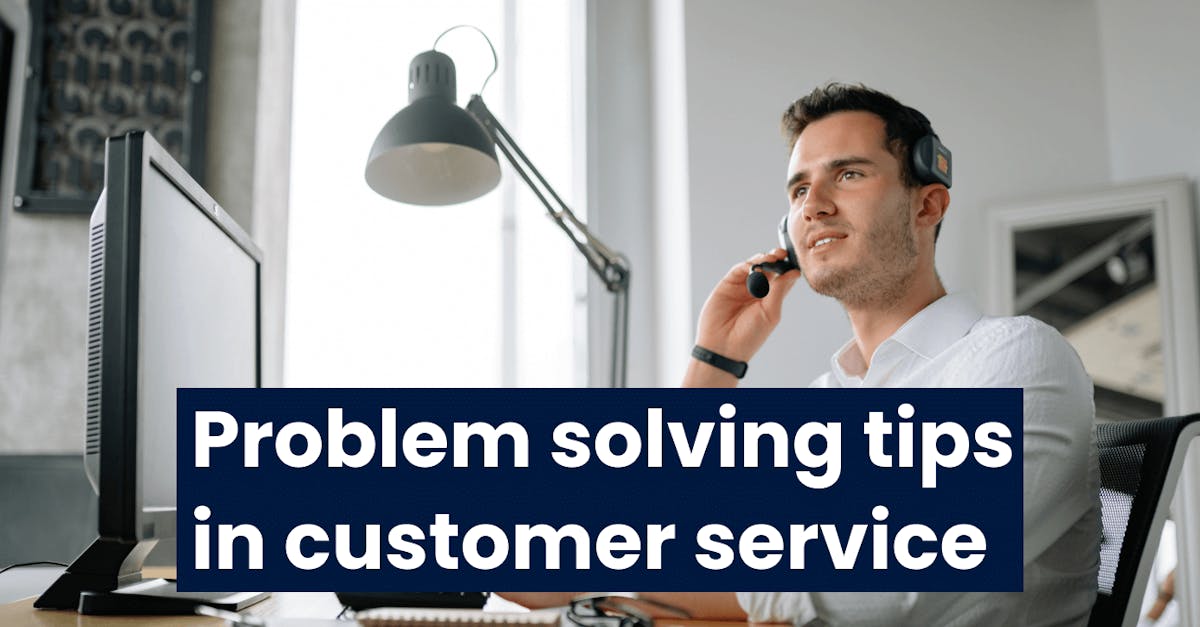
In the customer service world, challenges arise when you least expect them. Whether you're a seasoned professional or just starting, mastering the art of problem-solving is essential.
In this article, we’ll share with you 10 simple yet effective tips and techniques that will empower your team to navigate customer service issues like a pro.
From active listening to setting realistic expectations and offering solutions, these strategies will benefit your business by enhancing your team’s problem-solving skills and boosting customer satisfaction.
Why are problem-solving skills important in customer service?
Problem-solving skills are crucial in customer service because they turn frustrating situations into bright opportunities. When you effectively identify and address customer issues, you also show that you genuinely care about their satisfaction.
These skills build trust, improve customer loyalty, and lead to positive word-of-mouth recommendations. Moreover, they help your team handle challenges efficiently, reducing stress and improving overall job satisfaction.
In short, mastering problem-solving in customer service is the key to creating happy customers and a thriving, customer-centric business.
Customer Service Problem-Solving # 1 - Active Listening
Active listening is a vital technique in customer service problem-solving. It involves fully focusing on what the customer is saying, not just waiting for your turn to speak.

To practice it effectively, encourage your team to maintain eye contact, nod in acknowledgment, and use phrases like "I understand" to show empathy. Let them practice how to avoid interrupting and give customers the space to express themselves fully.
By truly hearing your customers’ concerns and needs, your team can respond more precisely and find solutions that leave customers feeling valued and satisfied. This successfully turns potentially challenging situations into positive experiences.
Edapp can empower your customer service team's problem-solving skills by offering interactive and customized training courses. These problem solving training courses include EdApp’s Problem Solver course. There’s also a course on Dealing with Difficult Customers .

Through scenario-based simulations, your team members can practice resolving real-life customer issues in a safe learning environment. Edapp's reporting and analytics features allow you to monitor individual progress, identify areas for improvement, and provide targeted feedback.
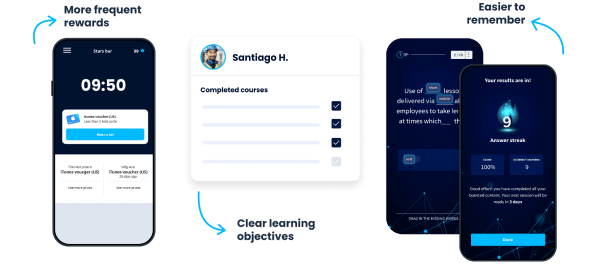
With the flexibility of mobile learning , your team can also access training anytime, anywhere, making it convenient to sharpen their problem-solving abilities. Plus, Edapp's engaging and adaptive content makes sure that your team stays motivated and develops the critical skills needed to excel in customer service problem-solving.
Sign up to EdApp for free to unlock your customer service team’s best potential.
Customer Service Problem-Solving # 2 - Stay Calm and Patient
Staying calm and patient is a superpower in problem-solving. When your team keeps their cool even in tough situations, it sends a reassuring message to the customer that they’re competent and there to help.

Some tips you can give them are to take deep breaths, to remember it's not personal, and to not rush through the conversation. Pausing to collect their thoughts can also lead to better solutions and prevent the situation from escalating.
With this customer service problem-solving skill, your team gains the upper hand in resolving issues effectively, creating happier customers, and making their jobs less stressful in the process.
Customer Service Problem-Solving # 3 - Apologize Sincerely
Apologizing sincerely is a golden technique in customer service. When your team members genuinely say, "I'm sorry," they show empathy and take responsibility for any inconvenience the customer has faced, regardless of fault.

This simple act of acknowledging their frustration can go a long way in diffusing tension and starting the path toward resolution when it comes to customer service problem solving. A sincere apology demonstrates that your customer service team cares about their experience and is committed to making it right.
So, don't let your team underestimate the power of a heartfelt "I'm sorry" in turning a customer's problem into an opportunity to leave them feeling valued and satisfied.
Customer Service Problem-Solving # 4 - Take Ownership
Taking ownership is a remarkable technique when dealing with customer problems. When your team members accept responsibility for resolving an issue, they send a clear message to the customer that their concerns matter to your business.

It doesn't matter if your product or service caused the problem. By taking ownership, your team demonstrates a commitment to finding a solution and ensuring their satisfaction. This step builds trust and confidence in your customers, showing that your team is there to support them every step of the way.
Encourage your team to say, "I'll take care of this for you." It's a powerful way to transform challenges into opportunities in exceptional customer service problem solving.
Customer Service Problem-Solving # 5 - Set Realistic Expectations
Setting realistic expectations is an important step for customer service problem solving. When you communicate clear timelines, you're being honest and transparent with what the customer can expect.

This helps manage their expectations and prevents disappointment down the road. Under-promising and over-delivering is a technique your team can use to make sure that they have the time and resources needed to meet or exceed the commitments they’ve made.
This technique not only prevents misunderstandings but also creates a positive experience by showing that your team is dependable and trustworthy. It ultimately makes customers happier and more satisfied with the service they receive.
Customer Service Problem-Solving # 6 - Collaborate with Colleagues
Letting your team members collaborate with their colleagues for problem-solving is like having a superhero team for customer service in your organization. Sometimes, challenges are complex, and it's perfectly okay to call in reinforcements.

They can also involve other team members or departments when needed, ensuring that they have all the expertise and resources at their disposal. Effective internal communication is the key here; so make sure that everyone is on the same page.
This customer service problem solving example helps find more comprehensive solutions and demonstrates a unified commitment to customer satisfaction. So, remind your team that they’re not alone in this mission–collaborate, conquer, and make your customers' day better together.
Customer Service Problem-Solving # 7 - Offer Solutions
Offering solutions is not just about acknowledging the issue; it's about actively seeking ways to fix it. Presenting practical solutions to the customer's problem shows that your team is dedicated to making things right and that customer satisfaction is their top priority.

So when faced with examples of problem-solving scenarios, have your team discuss the options, outlining the pros and cons if necessary, to help your customers make an informed decision.
Offering solutions not only resolves the immediate problem but also fosters trust and loyalty, leaving customers feeling heard, valued, and confident in your team’s ability to provide exceptional service.
Customer Service Problem-Solving # 8 - Follow-Up
Once the issue is resolved, your customer service team shouldn’t leave your customers hanging. They should take the extra step to check in with them.

Whether it's a quick email or a phone call, asking if everything is going well shows that your team genuinely cares about their satisfaction even after the problem is resolved. It's a fantastic way to ensure their needs are fully met and to gather valuable feedback for continuous improvement.
Following up not only leaves a lasting positive impression but also transforms a simple resolution into a memorable and delightful customer experience . So, remind your team to circle back and make sure that your customers are smiling long after the issue is history.
Customer Service Problem-Solving # 9 - Document the Interaction
When your team members keep detailed records of customer issues and the steps taken to resolve them, they’re creating a valuable resource for your customer service team.

These records offer a clear picture of past challenges and solutions, making it easier to spot trends and identify areas for improvement. Plus, they guarantee consistency in your service by allowing any team member to pick up where you left off, providing a seamless customer experience.
Think of documentation as your team’s secret weapon for conquering future customer service adventures, helping them navigate problems with confidence and precision.
Customer Service Problem-Solving # 10 - Learn from Each Case
After resolving an issue, let your team take a moment to reflect on what went well and what could be improved. Have them analyze customer feedback and common issues to identify patterns and trends.

By turning each case into a learning opportunity, your team can continually refine their problem-solving skills and fine-tune your business’s customer service approach.
It's the key to growth, making sure that you and your team are always ready to tackle new challenges with even greater expertise. This ultimately creates happier customers.
Donna is an elearning content writer for EdApp, a mobile-based microlearning platform designed for today's digital training needs. When she's not writing web articles, she writes lines of code or songs or anything food-related.
Explore more
Explore case studies
Learn how customers like you use EdApp. Their results speak for themselves.
Book a demo
Get a tour of our core products and features with one of our experts.
Take a bootcamp
Instantly access our video library updated weekly with live demonstrations.
Check out G2 reviews
Don't take our word for it. Here’s what our customers have to say.
- 888-636-1222
- Make a Payment | Contact Us

How to Improve Problem Solving Skills in Customer Service

Keeping customers happy pays off.
Happy customers buy more, generate positive word-of-mouth advertising, and create great referrals.
Unhappy customers complain, and they do it loudly. What’s worse, for every customer that complains, 26 stay quiet .
Delivering great customer service can be challenging, but why?
According to Jeff Toister of Toister Performance Solutions and author of three customer service books , there are five reasons why customer service is so hard:
- It’s not instinctive
- Our customers see what we don’t
- It’s sometimes hard to be friendly
- We aren’t good at multitasking
- Directed attention fatigue
So how do we overcome these challenges ?
Problem-solving.
“Every problem has a solution. You just have to be creative enough to find it.” Travis Kalanick
One of the main reasons our customers do business with us is because we solve a problem for them.
Depending on your product or service, your business can help customers:
- experience something new
- feel comfort
- become healthier
What problem does your business solve for your customers?
Problem -solving skills is vital to Customer Service
Solving a customers’ issue should be the goal of every one of your people.
But typically in the past, when an issue escalated to a certain point, help desk service or customer service reps (CSRs) were told to escalate these calls to a supervisor or manager.
More and more companies are asking customer service reps (CSRs) to handle these types of issues, not managers.
That’s a big change for many CSRs.
It’s also a task CSRs can get right with the proper problem -solving skills training . Failing is not an option for CSRs. It’s just too costly.
What is the impact of poor customer service?
Companies lost $75 billion in 2017 from customers switching to competitors because of bad service. That’s up $13 billion from 2016. With customers demands increasing each year, it doesn’t take much to disappoint customers with poor customer service. Obviously, CSRs need to be at the top of their games to keep customers happy.

This guide offers tips on how to help your people solve customer service problems quickly, efficiently, and cost-effectively.
The guide covers the following topics:
- Critical thinking in customer service
- Rules to help customer service people think critically
- Basic customer service problem-solving scenario
- Concrete steps to solve a customer problem
Keeping customers happy can boost customer loyalty, corporate productivity , and business profitability—goals for every company out there.
“Fall in love with the problem, not the solution.” Uri Levine
Critical Thinking in Customer Service
Delivering epic customer service is essential these days. But that’s easier said than done, given today’s more demanding customers.
Identify critical thinkers
To manage demanding customers requires someone highly skilled in troubleshooting—someone with the creativity to solve difficult problems.
All while under the pressure of the customer.
So, look for customer service people that are creative problem solvers when hiring new workers. These people have a penchant for thinking outside the box to solve problems.
That includes not just the ability to think rationally , but also the need to question the information given. Put simply, critical thinking is never taking anything for granted.
Build critical thinking skills
Customer service people can develop critical thinking skills with practice. In a post by Ransom Patterson on CollegeInfoGeek.com reveals seven ways people can improve critical thinking skills:
- ask basic questions
- question basic assumptions
- be aware of your mental processes
- try reversing thing
- evaluate existing evidence
- think for yourself
- remember you are not perfect
Apply these tips encourages critical thinking.
Another critical thinking technique CSRs can use is constructive controversy. A proven problem-solving method, constructive controversy helps you decide if a decision we’re making is the right one for you. Here’s more on this technique .

Basic Customer Service Problem-Solving Scenario
Savvy businesses aren’t afraid to provide employees with customer service problem-solving training.
One aspect of this training is learning the four phases of a problem-solving situation and what to do during each phase. See below:

Listen to customers
Listening is the first step in solving customer’s problems. It’s also the most critical. But customer service people often need training to do it well.
If customer service reps don’t listen, they won’t know the nature of a customer’s problem and its impact on him or her.
Sometimes, all customers want is for CSRs to lend a sympathetic ear. Other times, they need more.
Also, CSRs need to let customers vent without interrupting them.
Acknowledge customer’s pain
During this phase, CSRs need to acknowledge they heard customers and “feel” their pain.
Paraphrasing the problem back to a customer says you’ve done that. It also makes sure everyone is on the same page. If CSRs don’t fully understand the issue, they may end up providing the wrong solutions. Saying something like “I’m sorry you had to call us to deal with this issue” also helps.
Offer alternative solutions
If the issue is merely an oversight on the customer’s part, no remedy is needed.
But if the situation is the company’s fault or a product or service fails, you may need to offer alternative solutions.
Resolution is critical.
In this case, the customer not only didn’t get what he or she wanted but also were inconvenienced. That’s a bad combination no matter how you look at it. Going above and beyond by resolving the issue and offering a free product or service, a special coupon, or a gift voucher goes a long way with customers.
Execute/Follow-up
After agreeing on a solution, CSRs need to execute. Then, you need to follow up. That ensures that customers end up happy with the resolution and are satisfied with the outcome. If they’re not, then customer service people need to find a way to satisfy them.
Understanding these phases of a successful issue resolution is crucial when dealing with unhappy customers. It’s the “secret sauce” to keep buyers happy.
Extra: Be prepared
In addition to this approach, you may want to have some prepared responses to seven stock questions customers ask. They’re questions that almost every company gets:
- Why don’t you have it in stock?
- Why didn’t you or your company tell its customers?
- Why did I pay less the last time I was here?
- Can I have a refund because of this problem?
- You did it last time I was here?
- You said the problem/product was fixed?
- You said you’d call me when the problem was fixed.

Providing stock responses to these questions not only helps customer care people follow company guidelines but also keeps customers happy.
How to Handle Customer Service Issues: 9 Steps
Problem-solving often seems straightforward, but that’s not always the case. Sometimes, it’s complicated. Having workers well-versed in problem-solving skills and techniques for customer care representatives helps. Approaching issues in a systematic way simplifies the problem-solving process.
Below is a 9-step process that can help CSRs resolve even the most complex customer service issues:

Identify the problem
The key to doing this is to ask the right questions. Below are some customer service problem-solving interview questions:
- What is this call really about?
- Is there an underlying issue causing the problem the customer isn’t aware of?
- What does the customer want us to do?
- Is the issue being made worse by a known problem or bug?
- Is this issue identifying a repeated customer service problem or is it a new issue?
These questions can help CSRs pinpoint the real problem. It’s not always what customers think. Acknowledging the customer’s pain, as we said above, also helps.
Find out what customers need
Try to understand how customers see the issues involved and try to get a solid understanding of his or her needs. If appropriate, ask customers what they’ve done to resolve the issue.
Find out how the issue impacts the customer
Understanding how an issue affects a customer is crucial. It helps CSRs not only connect with the customer but also prioritize tasks.
Clearly define the root of the problem
Having identified the problem in steps 1 to 3, you now need to understand what caused the problem. By identifying the cause of the problem, you will have a better idea of how to solve it. Also, you will know how to avoid a simialr problem in the future.
Produce possible solutions
Knowing the problem, your customer care person needs to start brainstorming solutions. They also need to find out what solutions other co-workers may have used to solve the problem. CSRs can then generate a list of potential solutions.
Evaluate each solution and pick the best
Evaluate all the solutions. Decide if you have the resources to implement it, how much the solution costs, how long it will take to execute it, will it resolve the issue, and if it follows company policy.
Plan the solution’s implementation
Some solutions are easy to execute. Others are harder. For harder solutions, think about who will execute the solution, what will it costs, when and where you will execute it, and how will it be implemented. Also, double check out the benefits of the solution.
Discuss the solution with customers
Having nailed down the solution’s details, discuss it with the customer. Walk through it with him or her step by step and ask for feedback. Be ready to adjust the plan. Execute the solution — After the customer approves the solution, it’s time to execute it. Follow up to certify the progress of the solution, that you’re meeting any deadlines and where you stand with the budget. Re-work your plan, if necessary.
Analyze the results
Having finished the implementation, analyze the results. Use quantitative and qualitative data, if available. Can you improve the solution? Also, ask the customer if the resolution met their expectations. That’s critical.
This ten-step process may seem a bit much for call center agents, technical support people, and customer care representatives to tackle. But using it works.
Having customer care people go through it step by step helps your CSRs quickly resolve customer issues the first time that customers call. Track resolution time to see how your CSRs are doing.
Resolving issues when customers contact your business keeps them happy.
Happy customers buy more, generate positive word-of-mouth advertising, and create outstanding online referrals. On average, a happy customer tells nine people about their experience with you.
Keeping customers happy is the secret to boosting customer loyalty, increasing profitability, and differentiating you from competitors. Doing those things can take your company to the next level.
Unicom Teleservices
Related posts.

Active Listening Customer Service: Key to Business Success

What Is A Warm Transfer?

What Is a Good Definition of Customer Service?
The Guide to Effective Customer Service Problem Solving

Cases that start as “I don’t know” quickly become “I figured it out!”
“I don’t know” isn’t a good enough answer in customer support. When customers come to you with unique problems and unusual questions, we can’t refuse to answer them. In this guide, we’ll give you the steps to turn that “I don’t know” into something better:
“I don’t know, but I’m going to figure it out.”
With this guide to effective customer service problem solving, we give you a three-step process to follow:
- take stock of the information you’ve been given,
- gather any additional information you need,
- and then work to solve the problem and respond to the customer.
Let’s get started.
Assess the information you have
Information is the most important tool in your tool belt. The first step in solving any problem is to identify all the information you already know. Whether this case was escalated to you for help, or if you’ve just realized that there may be more than meets the eye to this problem, take the time to lay out everything you know.
Customer’s tone
How does your customer feel about the situation? Are they technically minded, or are they struggling to describe technical issues ? Are they calm and cooperative? Or combative and frustrated? Is this a deal-breaker for them? Or is it just a weird bug? The demeanor of your customer will inform how you approach the situation going forward.
Customer’s history
Do a quick review of the customer’s previous support interactions, any purchases they’ve made, what plan type they are on, etc. This context will help you replicate the issue, as well as respond appropriately to the customer.
What’s happening?
Do you know enough about what’s happening? Have they sent through screenshots? Error messages? Console data? What were they trying to accomplish? It doesn’t need to be a technical problem for this step to still be important. Understanding what the customer’s motivation is will help solve a variety of issues.
Has this happened before?
It’s very unlikely that this is a brand new problem. Has the customer reported it happening before? Has any other customer reported it happening before? Help desk search functions are incredibly powerful tools. Search error messages and problem statements to see if other customers have reported similar issues. You can also search the internet to see if it’s a third-party issue. For example, if you’re using a third-party payment system, you might be seeing one of their errors when customers are purchasing on your website.
Gather more information
Okay, we’re partway there! If you didn’t have an epiphany while you were sorting through the information already at your disposal (sometimes that happens!), it’s time to gather more data.
Can you replicate it?
There’s no way to get more information than to get hands-on with the problem. Do you see the same thing happening?
If not, what information do you need to replicate it?
If you can’t replicate the issue, it’s probably because you’re doing something different or in a different environment. What information do you already have about the customer’s environment? What do you need to know in order to do exactly the same thing?
- Environment: browser version, extensions (try it incognito?), other settings.
- Steps: can they record a screengrab? What are they trying to do? What error message do they get?
- Specific settings: what account are they using? What version of your product are they using? If you can try it in their account (using “admin mode” or “god mode” so you can see it without asking for their username or password), does it happen for you as well?
Ask other people
Now’s the time to check in with other people on your team to see if they have any ideas. Have they ever seen something similar?
Depending on your relationship with your product and engineering team, you may also be able to check in with them at this point. However, many teams have a more formal bug reporting process in place to prevent “side of the desk” questions from interfering with their workflow. If that’s the case, you may want to do more research first.
Solve the problem
Now you’ll need to actually solve the problem for the customer. It might require finding a workaround, or reporting a bug to the development team.
Bug or works-as-designed?
Once you’ve replicated the issue, you’ll need to decide whether that is the way it’s supposed to work, or if you’ve found a bug. If it’s a bug, congrats! You can file a bug ticket and ask your engineering team to fix it. If it’s a feature or a design flaw, you may need to make a case for an update. In this case, the complex problem may turn into a feature request.
Is there a workaround?
Can you get to the customer’s desired end result in another way? Whether the issue turns out to be a bug or a feature, if you can find another way to achieve their goal, your customer will be happy!
Write a great response
Once you’ve replicated the issue, solved the problem, found a workable solution, or at least documented the bug for a future fix, you need to get back to the customer. Writing an empathetic, thorough response can make all the difference in a complex situation.
In many cases, your response will follow the same steps as a great customer service apology :
- Offer explanation
- Fix the problem
- Wrap it up and let them know what’s next
Resources for Customer Service Problem Solving
We all need a little help sometimes. If you’re learning how to fix more difficult problems, these resources can help.
Help Scout’s Art of Troubleshooting
On a mission to troubleshoot a bug? This guide is super helpful .
Support Details website

Learn how to use Developer Tools, especially Web Consoles

Be like Sherlock, and look for clues!
Customer support requires communication skills and problem-solving skills. Looking for the clues to solve the puzzle becomes a big part of your job as soon as you start to take on more difficult customers. With this guide to customer service problem solving, you’ll have a systematic way to approach those tough questions. Cases that start as “I don’t know” quickly become “I figured it out!”
How did you like this blog?

Sarah Chambers is a Customer Support Consultant and Content Creator from Vancouver, Canada. When she’s not arguing about customer service, she’s usually outdoors rock climbing or snowboarding. Follow her on Twitter @sarahleeyoga to keep up with her adventures.
Related articles

7 Support Phrases Customers Hate to Hear (and What to Say Instead)
How to respond to negative reviews about your business, how to write a helpful bug report that gets your issue fixed, the best customer service tips every week. no spam, we promise..
Get guides, support templates, and discounts first. Join us.
Are you a freelance writer? Do you want your articles published on Nicereply blog?
Get in touch with us
Sales | How To
12 Common Customer Service Problems & How to Resolve Them
Published September 4, 2023
Published Sep 4, 2023
WRITTEN BY: Bianca Caballero
This article is part of a larger series on Customer Service .
- 1 Service Not Aligned With Customer Journey
- 2 Difficulty Maintaining Quick Response Times
- 3 Rude Behavior of Support Agent
- 4 Frequent Call Transfers
- 5 Difficulty Accessing Live Human Agent
- 6 Using the Wrong Tools & Software
- 7 Relying on Limited Support Channels
- 8 Inadequate Training for Service Reps
- 9 Pushing the Wrong Product or Service
- 10 Failure to Deliver Promised Solutions
- 11 Treating Customers as Mere Numbers
- 12 Website or Software Outage
- 13 Frequently Asked Questions (FAQs)
- 14 Bottom Line
Customer service problems can harm your business, affecting customer satisfaction, trust, and loyalty. Some of the most common issues in customer service are slow response time, rude communication by the support staff, and lack of real-time engagement. Continue reading as we discuss the reasons for these issues, give tips on how to solve customer service problems, and share tools that can effectively support your teams.
1. Service Not Aligned With Customer Journey
Over 70% of consumers expect businesses to provide a conversational care experience during their interactions. Unfortunately, you could easily fall into the trap of inconsistent service when customer service is not properly aligned with the customer journey. This could happen to any small business customer service team, especially those growing and expanding quickly.
Solution: Map out your customer journey to understand your clients’ behavior, interests, needs, and most preferred channels. If you are using several support channels, use a tool like Freshdesk that can unify all customer conversations in an omnichannel platform. This way, you can easily monitor all rep engagement and performance with just a single solution.
Visit Freshdesk
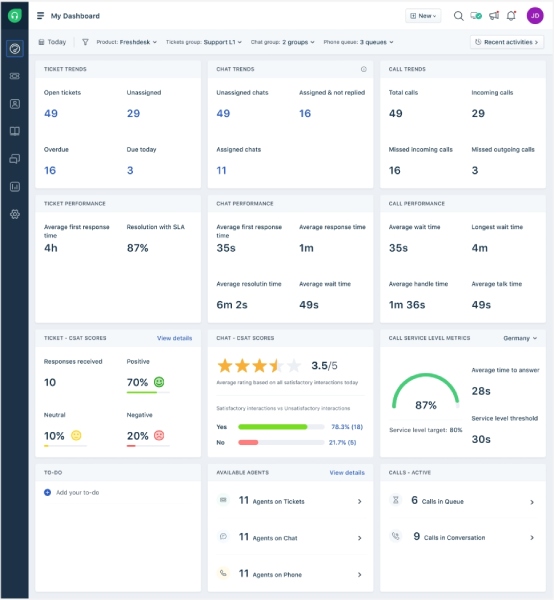
Freshdesk omnichannel dashboard with a birds-eye view of the support team’s performance across channels (Source: Freshdesk )
Curious about how this platform can help your business grow? Read our comprehensive Freshdesk review and learn how to solve problems in customer service with the help of this tool.
2. Difficulty Maintaining Quick Response Times
Consumers often expect instant or quick customer service problem-solving. In fact, 70% of customers say the acceptable response should come within the same day the request was sent. Almost half (46%) are willing to wait until the next day, and only 16% would wait up to three days. However, factors such as insufficient manpower and lack of tools like live chat could affect queue time significantly.
Solution: Aside from adding more personnel, integrate a customized live chat widget to your support channels to help your agents respond faster to customer queries. A platform like LiveChat lets you handle multiple conversations at the same time, reduces the queue, and helps increase the customer satisfaction (CSAT) rate.
Visit LiveChat
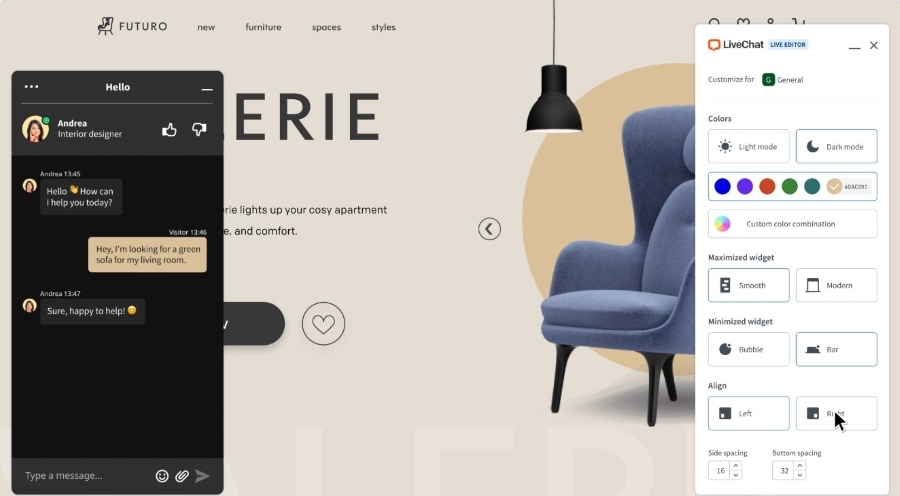
An example of LiveChat’s customizable chat widget (Source: LiveChat )
3. Rude Behavior of Support Agent
Customer service reps could exhibit rude behavior for several reasons. These could include constant challenges to customer service solutions, a rude customer unprovoked by the rep, and personal issues that the rep could not push aside at the moment. However, no matter how irate the customer becomes, a rep should not be rude to a customer.
Rude communication and behavior from customer support staff is one of the worst things for a business. There are instances where human reps are pushed to their limit and unintentionally lash out at customers. Fortunately, 80% of consumers will forgive a company for a mistake after receiving excellent customer service. This is why it is important to integrate basic customer service etiquette into your business.
Solution: Train your customer service reps on using the right words when interacting with different types of customers and how to politely say no to a customer request. You can also provide live chat scripts to help them deliver consistent responses in different situations.
Want to learn the best practices for customer service communication? Read our article on customer service response templates to learn about the standard replies to customers’ most common complaints and issues. Download these templates for free and customize them to reflect your brand voice in your chat scripts.
FILE TO DOWNLOAD OR INTEGRATE
FREE Customer Service Response Templates
Thank you for downloading!
4. frequent call transfers.
Agents sometimes have to transfer a customer to another agent when they don’t have an immediate solution to the query. This also happens when the rep feels like another agent or a superior can offer a better customer resolution. For consumers, it’s frustrating to have to repeat the process of detailing their concerns each time they are transferred.
Solution: Use a customer service tool with intelligent routing capabilities to direct tickets and conversations to the right agent or department. Zoho Desk, for example, allows you to set up skills-based routing so that incoming support tickets go directly to specific agents based on their skills. This way, you can avoid or minimize the transfer of conversations and facilitate quick resolution of customer service issues.
Visit Zoho CRM
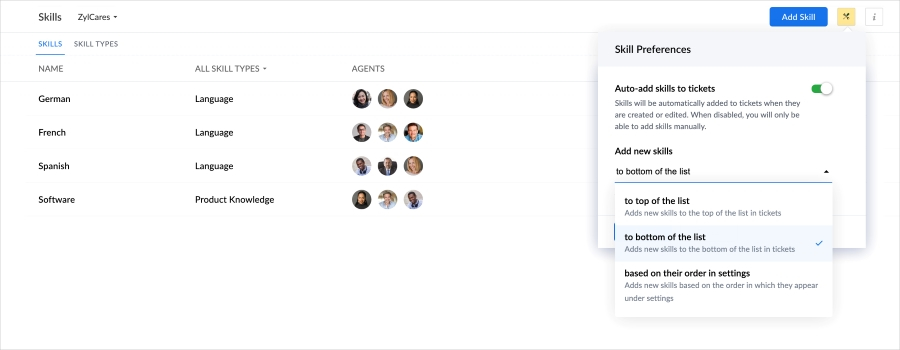
Zoho Desk skills-based ticket routing (Source: Zoho )
Interested in learning more about this platform’s features and capabilities? Check out our in-depth Zoho Desk review .
5. Difficulty Accessing Live Human Agent
Studies show that 69% of customers are willing to interact with a chatbot for simple issues and frequently asked questions (FAQs). Automation should be used to start a conversation with a customer and to minimize customer wait time, but you should know when to use chatbots and human live chat . For instance, complicated customer problems like payment disputes require elaborative conversations with a human agent.
Solution: Pick the right tasks to automate based on the type of queries you receive. For instance, self-service and knowledge bases work best for predictable FAQs. Alternative support channels like live chat and email allow your customers to connect with human agents to discuss more complex issues, such as payment disputes. If you primarily use chatbots to connect with customers, choose a chatbot platform like Landbot that offers an option to transfer the conversation to a live human agent.
Visit Landbot
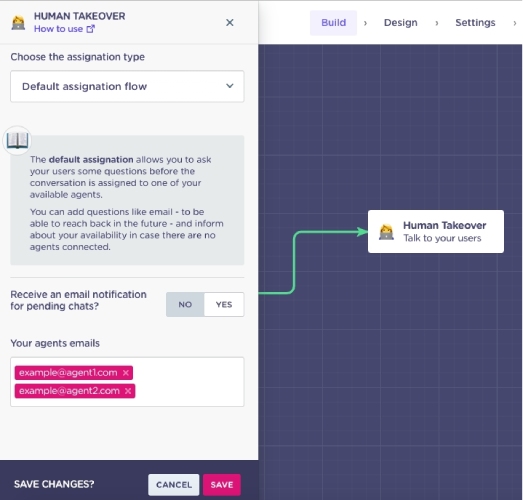
Landbot human takeover of chatbot conversation (Source: Landbot )
6. Using the Wrong Tools & Software
There are several factors that go into selecting software and tools for your business. These include your unique operational requirements, budget, and feature needs. Choosing software that does not fit your business needs could lead to complicated service processes, slow response times, and decreased satisfaction among reps and customers.
Data shows that 60% of high-growth businesses use help desk software to enable their support team. Other top options include a knowledge base, shared email alias, customer relationship manager (CRM), live chat, and support tickets.
Solution: Work with your sales, marketing, and customer service departments to find the right software that fits your unique business needs. You can select from several options, including CRMs, ticketing systems, and help desk software. You can also read our guide on how to choose help desk software and follow the steps in this article to ensure that you pick the right platform.
7. Relying on Limited Support Channels
Online portals and email ticketing are still among the top customer support channels that customers prefer. However, there are situations, such as in troubleshooting, where customers are not satisfied with live chat support and would seek a face-to-face conversation to resolve the issue. Statistics show that almost half (46%) of customers prefer to engage with service reps in person, and 59% want access to phone support.
Solution: Use video and voice chat to quickly identify the root cause of the issue and solve customer problems. You can also collaborate using co-browsing, which allows you to control the customer’s screen, and help them fill out complex forms. A platform like REVE Chat offers both co-browsing and video calls for more efficient troubleshooting.
Visit REVE Chat
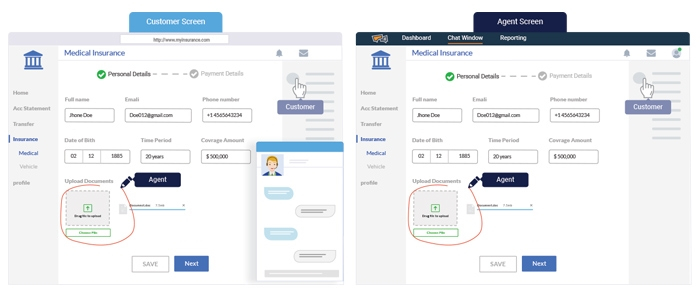
REVE Chat co-browsing feature lets an agent jointly navigate a customer’s screen. (Source: REVE Chat )
8. Inadequate Training for Service Reps
More than half (68%) of customers feel that most businesses need better training for their customer service agents. This could be due to several reasons, including the lack of solution guidelines for specific customer queries and inadequate training on proper communication. Businesses should ensure that their agents are well-equipped to deal with different types of issues in their field to maintain good customer experience.
Solution: Conduct regular and thorough product training sessions to build a solid foundation of your reps’ product knowledge. You also have to monitor and evaluate customer engagement to check if your reps are providing the correct information to customers. Read our list of the top customer service training topics and ideas and use it to bring out your team’s full potential.
9. Pushing the Wrong Product or Service
There are times when reps offer the wrong product because they are unable to understand what their customers want or need. Other factors that could contribute to this problem include lengthy and unclear conversations, a one-size-fits-all approach to all customer issues, or the lack of a competitive analysis of customer needs. All these could lead to a rep mistakenly pushing the wrong product or service to a customer.
While better deals and product quality primarily drive brand defection among consumers, 48% of customers switch to another brand in search of better customer service. No matter what the reason is, offering the wrong product to a customer reflects poorly on the company you are working for.
Solution: On top of proper training (mentioned above), it is also wise to gain insights from visitor analytics first before offering customers a product. Use a tool like HubSpot to track customer behavior in real time and gather valuable insights into their activities on your business website. This way, you can gauge their interest in a certain product or recommend another one based on what they need or want.
Visit HubSpot
HubSpot contact website activity tracking (Source: HubSpot )
Want to know more about this platform’s customer service features? Head on to our HubSpot Service Hub review page .
10. Failure to Deliver Promised Solutions
Failure to deliver a promised solution impacts your brand negatively. On the other hand, doing what you promised would help improve customer satisfaction (CSAT) , especially because their expectations of you will continue to rise. Research shows that 68% of customers trust businesses to tell them the truth. That said, don’t make any promises you can’t keep to avoid losing customers’ trust.
For example, if your company promises to respond to support requests within 24 hours, your team should aim to do so on or before the promised deadline. Anything beyond that deadline should be unacceptable because it would lead to a breach of trust.
Solution: As part of your customer service strategy , have a properly defined plan for solving customer service problems. This plan should include setting a timeline for every solution you offer customers—making the customer feel that your team is taking your issue seriously and is working to resolve it shortly. Check out our guide to measuring customer satisfaction to get an overview of your service team’s performance.
11. Treating Customers as Mere Numbers
Lack of after-sales support could make your customers feel deserted, and sadly, 56% of customers feel that companies treat them as mere numbers. Some businesses are done interacting with customers once they close a sale. This should not be the case. Excellent customer service involves making your customers feel appreciated even after they have made a purchase.
Solution: Make regular follow-ups with customers so you’ll know if they encounter issues with your product. You can also send personalized thank-you notes via email or tags on social media. These simple gestures show how much you care for your customers.
Interested in simplifying your customer follow-up communication? Download and customize our free sales and customer service follow up templates to check in with your customers after closing a sale.
FREE Follow-up Templates
12. Website or Software Outage
Service downtime could happen to every business, and one out of five organizations report experiencing severe outages that cause significant financial losses. Such a situation will cause your customers to panic and bombard the customer support line with calls or requests. It is difficult to deal with the influx of support calls and the fact that these occurrences are out of your control.
Solution: Establish a service level agreement (SLA) between your company and your software providers to outline your expected level of performance and set uptime. It should also include the consequences of violating this agreement. In addition, it helps to be transparent with your customers about service outages and the estimated time to resolution.
Frequently Asked Questions (FAQs)
What are the types of complaining customers.
Complaining customers generally fall into five categories:
- Meek: Avoids confrontation and only makes their customer complaint known when you actively seek feedback
- Aggressive: Complains loudly and tends to be dismissive of reasons for an unsatisfactory service
- High-roller: Expects the highest level of customer service and is willing to pay for it
- Rip-off: More interested in getting something they are not entitled to receive rather than actually solving customer problems
- Chronic: Never satisfied with any solution and will always find something to complain about
Why is bad customer service a problem?
Bad customer service could lead to lost revenue and lower profits. When you ignore customers’ needs and provide them with bad experiences, you might lose them to your competitors. Aside from losing your current customers, it could also prevent you from acquiring new ones. This is why it is very important to know how to solve customer service problems.
How do you resolve customer service problems?
Problem-solving and troubleshooting customer issues involve the following steps:
- Ask relevant questions to find out what is upsetting the customer.
- Identify the problem and describe it precisely.
- Formulate various solutions and present them to the customer.
- Deliver the promised solution within a reasonable time frame.
- Follow up with customers to assess their satisfaction with the solution.
Bottom Line
Customer service problems are inevitable and will continue to evolve as customer expectations change over time. The important thing to do is to have a well-outlined plan on how to solve customer service problems quickly and effectively. You should also invest in good customer support tools that can help you manage and streamline customer engagement, as well as monitor your team’s performance with ease.
About the Author

Find Bianca On LinkedIn
Bianca Caballero
Bianca Caballero is a subject matter expert at Fit Small Business who covers Sales and Customer service topics. Prior to working at FSB, she was in field sales and territory management. When she launched her career as a writer, she worked with companies from the US, Australia, and China. At present, she uses her 12+ years of writing experience to provide FSB readers with the best answers to their questions.
Join Fit Small Business
Sign up to receive more well-researched small business articles and topics in your inbox, personalized for you. Select the newsletters you’re interested in below.
Welcome to Consumer Rescue
Fiascos and Fixes

7 simple ways to get excellent customer service and fix any problem!
Michelle Couch-Friedman
Consumer reporter and ombudsman
July 6, 2022
It isn’t just wishful thinking to say that every consumer can get excellent customer service. But it does take some effort and strategy.
During my many years as a consumer advocate, I’ve tackled some of the most shocking customer service failures imaginable. I’ve retrieved hundreds of thousands of dollars from companies for consumers who were on the verge of giving up.
But what caused these customer service failures?
Part of the problem is that the number of poorly trained, ineffective “problem-solvers” that companies have unleashed on their customers has exploded in recent years. Even worse, some businesses have given up on human support entirely, outsourcing customer service to Artificial Intelligence (AI).
But the truth is that consumers have proven to be their own biggest enemy in many cases I’ve mediated. From threatening lawsuits after small slights to email-bombing the same complaint to every executive in the company and even fibbing about facts, I’ve seen it all. The result? Nothing positive for the consumer.
I know this all sounds grim. But never fear!
There are a few simple ways to increase your chances of getting excellent customer service whenever you need it. I promise that if you follow these easy steps, you’ll be equipped to resolve almost any consumer problem on your own. (But don’t worry, Consumer Rescue will always be here when you need us.)
Here we go.
1. Make sure you understand the company’s terms and conditions
Step number one is the foundation for this problem-solving methodology. Before contacting customer service with your complaint, it’s critical to ensure that the company’s terms and conditions align with the basis of your grievance. And make sure that your request is reasonable.
Many times, I’ve received requests for help from consumers who’ve failed to understand the terms and conditions of the company. In a recent case, I was contacted by a United Airlines customer who hoped the airline would give him $10,000 in cash for a flight delay. When United understandably balked, he was dismayed and hoped I could mediate his desired outcome. (FYI: I could not and would not.) In another case, a passenger wanted a refund for a business class seat on a flight to Europe — after she returned from the journey.
The bottom line: Every company has its own unique terms and conditions. Arm yourself with that information before you contact customer service with a problem. If the company has not deviated from its policies, what you’re asking for is a goodwill gesture( especially if you end up cruising without your clothes because you misunderstood the services provided by your hotel), and you’ll need to adjust your “complaint” to reflect that fact.
2. Always remain clear, concise and cordial
Many consumers want to unload on the customer service agent they reach. This is a mistake.
Your goal is to make the employee in charge of problem-solving actually want to help you. Keep in mind that customer service agents receive hundreds of calls and messages from angry people as part of their work. You’ll want to make your call or email stand out in a good way. You can do that by communicating in a concise, clear, and cordial manner. Refrain from promising to never use the company again OR threatening a lawsuit.
One of the biggest stumbling blocks consumers often hit when formulating their complaints is their inability to keep their communication concise. It’s important to remember that burying the actual problem in extraneous information is a quick way to lose the attention (and interest) of customer service.
Case in point? Last spring Stan Fernald sent me a request for help with a $4,000 problem. He had made a bid to upgrade his cabin aboard his Royal Caribbean cruise. He won the bid, but it turned out that the cabin was a significant downgrade. You can read his full story here:
- Royal Caribbean accepted my $4,200 upgrade bid for a downgraded cabin!
The cruise line made a mistake in billing him for the transaction, but his explanation of the problem was long and confusing. So the RCCL customer service, and later the executive office, rejected his refund request.
But I could see that he was owed a refund based on the actual details of the case.
Unfortunately, no one at RCCL had been able to wade through his lengthy explanation, details and request. (Fernald got his refund after I sent our executive contacts at the cruise line an abridged explanation).
The bottom line: The customer service agents you’re reaching have hundreds of cases they’re processing. Keep your email short and sweet.
Pro tip: Ask a friend to review your consumer complaint is clear before you send it to make sure that it is easily understandable . Leave out any extraneous information that won’t help the representative get the picture.
3. Stay off the phone. Document your complaint in writing
If you initially tried to resolve your issue over the phone and that was not successful, it’s definitely time to prepare your written complaint. You’ll want to use email, text, chat features, and any other media that helps you create a paper trail documenting your request and the company’s response.
- Pro tip : Use as many modern-day tactics as you can to document your situation: Screenshots, chats, emails, social media public posts, — even recording phone calls for your protection (Check the laws in your state. You may need to alert the other person that you are recording). Document, document, document!
It’s no secret that customer service representatives often promise many things to get a consumer off the phone. Later, when the customer tries to hold the company to the offer, it becomes a “he said, she said” situation. Remember, if it isn’t in writing, then you’ll have no way to prove the promise happened.
“I was told” is one of the most useless phrases you have when trying to escalate your complaint up the executive chain. You want to be able to show proof of what a customer service agent told you. You do that by keeping all of your problem-solving efforts in writing.
Things to remember when writing your customer service complaint
- Be cordial: Keep the tone of the message cordial (see Tip #2 above).
- Keep it concise: Try to keep your customer service complaint contained in one concise paragraph – five to six sentences.
- Do not send an email blast to ten company employees. When you do that, it’s easy for your letter to be ignored by all recipients. Each person can assume someone else will take care of the problem.
- End the request with your desired resolution. If you leave it up to the company to guess your hoped-for results, you will likely end up disappointed. Always tell the business what outcome would make you happy. But also…
- Don’t exaggerate the problem. Exaggerating or fibbing about aspects of your experience is another quick way to get your request for help to land in the virtual garbage can. Stick with the facts and steer clear of making outlandish accusations .
- Make sure your request is reasonable. Ask a few friends to review your complaint and your desired resolution. It’s important not to overshoot your compensation mark here; otherwise, if you ask for too much, you could easily end up with nothing. Remember to keep your suggested resolution reasonable .
The bottom line: It’s much more difficult for a company to ignore your written complaint. Keep a careful record of your efforts to resolve your problem. Make certain that your desired outcome is reasonable, and don’t stretch the truth in your complaint.
4. If at first you don’t succeed: Escalate your customer service issue
During the pandemic, many customer service employees lost their jobs – especially in the travel industry. Companies cut back on customer service and implemented a number of “consumer-unfriendly” business practices.
So today, consumers must be more determined than ever to stay the course as they’re trying to fix their problem with a company. That means if the first person you reach within the company ignores you or gives you a “No,” you’ll need to escalate your problem to someone else.
Here’s how to find someone within the company who can actually help you.
Consumer Rescue: Just Ask Meera! (Your research valet)
Consumer Rescue has a dedicated advocate who loves finding the executives you need to escalate your problem. Meera Sundram is the former research director of Elliott Advocacy, who worked by my side for many years, volunteering her time cultivating a giant database of customer service executives to help consumers navigate their problems with businesses.
Meera is here at Consumer Rescue with that database, ready to answer your personalized requests. Just Ask Meera is a unique feature available to our readers at Consumer Rescue. It’s especially handy for obscure company contacts not readily available elsewhere. You tell her what company you’re having a problem with, and she’ll give you the name and email of someone there who can help.
Search LinkedIn for executive customer service contacts
Another great way to find someone within a company who can help you resolve your customer service issue is through LinkedIn. Just use the Google search engine and enter terms like “Senior Customer Service” or “Executive Customer Service” for the company you’re having a problem with. Almost always, you’ll be directed to the LinkedIn profile of the person who holds that position in that business.
The bottom line: Don’t give up when you know you’re in the right. If the first customer service agent you reach can’t help, keep traveling up the corporate ladder until someone you find someone who can. Remember, many lower-level customer service level employees have limited power to grant your resolution. Stay the course, and you’ll find someone who has the authority to help.

5. File a complaint with your state Attorney General or private attorney
If the company continues to rebuff your requests, you can file a complaint with the Attorney General (AG) in your state (Here’s how to find the Attorney General in your state ). When an AG’s office receives a significant number of complaints about a specific company, it may launch an investigation. But minimally, its team will send a formal request to the company asking for an explanation. That inquiry may be all that’s needed to nudge the business to resolve the problem.
If that doesn’t work, you may need to consult with an attorney. You can get a referral from yo ur state’s Bar Association here .
The bottom line: For many consumers, the legal route may be cost-prohibitive unless the dollar value of the claim is very high. But your state’s AG’s office might be able to “encourage” the company to do the right thing. That assistance is free.
6. File a credit card dispute
This is a tricky step. For a number of reasons, a credit card dispute can easily backfire on consumers . You should only file a credit card dispute as a last resort. The Fair Credit Billing Act allows credit card-using consumers to initiate a credit card dispute when there is a billing error or fraud.
It’s important to understand the limitations of a credit card dispute. If you win a credit card dispute, this only ends your credit card company’s involvement in your case. The business that you were battling is still free to pursue the debt elsewhere and you might find yourself in collections. Or the company might ban you from using their services in the future.
Bottom Line: Make sure all facts are on your side. Only file a credit card chargeback as a last resort. Familiarize yourself with the limitations of a credit card chargeback. It’s not the magic bullet that many consumers believe it to be.
7. Ask Consumer Rescue to intervene in your customer service problem
If you’ve followed all of our guidance and you’ve still been unable to get a satisfactory resolution, Consumer Rescue is ready to help you.
For nearly a decade, fellow consumer advocate Dwayne Coward and I have worked side by side working to resolve thousands of consumer cases. Together, we’ve retrieved hundreds of thousands of dollars from companies and put it back in the pockets of the people who contact us…right where it belongs.
Unless there is a catastrophic customer service failure, most reputable companies will not allow your problem to escalate this far. But if it happens, you can submit your request for help to Consumer Rescue . One of us will get back to you, lickety-split!
The Consumer Rescue team is dedicated to defending consumers — always friendly and always free of charge.
🤗 ( Michelle Couch-Friedman , Ombudsman)
Subscribe To Our Friendly & Free Weekly Newsletter!
What you'll get: Our super-friendly and informative free weekly email. It's filled with helpful consumer guidance, tips, and links to all of our latest articles.
Success in your inbox
Get monthly insights handpicked by our editorial team. Act on it.

Connect with customers
LiveChat is a complete customer service platform that delights your customers and fuels your sales.
Trusted by 36,000+ companies

LiveChat helps you delight your customers and fuels your sales.
4 steps to effective customer service problem solving with examples.
- Post on Twitter
- Share on Facebook
- Post on LinkedIn
- Post on Reddit
- copy-button#copy track#send" data-controller="track" data-track-category="Success" data-track-action="Share" data-track-label="Copy link" > Copy link to clipboard Link copied to clipboard https://text.com/success/effective-customer-service-problem-solving/
Recently, I came across a fascinating customer service story involving an American Express cardholder. It all began with a seemingly innocent mistake while making a payment involving a decimal point in the wrong spot, resulting in the customer inadvertently paying thousands of dollars instead of hundreds.
Determined to rectify the error and seek guidance, the customer promptly contacted American Express to report the issue. To his relief, a representative assured him that the mistake would have no adverse impact on his account and that all charges would be promptly refunded. Little did he know that this was just the prologue to a series of challenges.
A few days later, the customer was taken aback when he discovered that all his debit cards were unexpectedly suspended. Perplexed and concerned, he went over his account for any indications of suspicious activity or an account block, but to no avail. Thus, he decided to reach out to American Express once more to seek clarification.
To his utter surprise and dismay, the representative he connected with not only questioned why he had not halted the incorrect payment but also accused him of attempting fraud. The customer explained that a previous representative had not advised him to stop the payment and had, in fact, assured him that there would be no negative consequences resulting from his honest mistake.
The response?
That's what customer service does. They tell you what you want to hear.
This quite nasty customer service story inspired me to write about the real purpose of customer service. Which is not “telling customers what they want to hear” but helping customers and resolving their problems.
In this article, you’ll also learn some troubleshooting techniques to make your job easier.
Creating a Good Customer-Centric Culture
A customer-centric culture serves as the bedrock of exceptional problem-solving and sustainable business success. In a world where customers today wield unparalleled power and influence, placing them at the heart of your operations is not just a choice; it is a strategic imperative.
At all levels of the organisation, employees must wholeheartedly prioritise customer happiness, understanding that every interaction is an opportunity to leave a lasting impact. By cultivating such a culture, businesses create a positive and supportive environment that empowers employees to go above and beyond to delight customers.
Nurturing this culture demands a multifaceted approach. One potent strategy is to recognise and reward outstanding customer service efforts. By celebrating employees who embody the customer-centric ethos, businesses reinforce the value they place on exceptional experiences. This recognition motivates individuals to exceed customer expectations continually and sets a powerful example for others to follow.
Encouraging collaboration is another pivotal aspect of fostering a customer-centric culture. In today's interconnected business landscape, problems seldom fit neatly within departmental silos. Emphasising collaboration cultivates a shared sense of responsibility for customer success and enables employees to pool their expertise, collectively devising innovative solutions that surpass individual capabilities. The result is a seamless and consistent experience for customers, who benefit from the collective effort of a united organisation.
To equip employees for the challenges of modern customer service, businesses must invest in skills training. Outstanding problem-solving skills do not materialise by chance; they are honed through intentional development. Equipping employees with the necessary tools and knowledge to navigate diverse customer interactions positions them to respond adeptly and confidently, even in the face of dissatisfied customers.
Customer Service Problem-Solving
Speaking of dissatisfied customers, they hold the key to unlocking greater customer retention. Rather than viewing poor experiences as a liability, businesses must embrace them as opportunities for growth. Each negative interaction presents a chance to introspect, identify pain points, and make tangible improvements. By actively seeking feedback from dissatisfied customers, businesses demonstrate their commitment to listening and learning, earning trust and loyalty in the process.
A customer-centric culture is more than a mere buzzword; it drives superior customer experiences and enhanced customer retention. By prioritising customer satisfaction at every touchpoint, celebrating exceptional service, fostering collaboration, investing in skills training, and actively engaging with dissatisfied customers, businesses can forge a path to sustained success and unmatched customer loyalty. Embrace the customer-centric ethos, and you will unlock the true potential of your organisation in a customer-centric world.
Strategies for Effective Customer Service Problem-Solving
Timely response and resolution are essential components of successful troubleshooting. Customers appreciate swift action, showing that their concerns are taken seriously. Personalisation also plays a significant role, as customers feel valued when their issues are treated individually rather than generically.
Navigating challenging situations with irate customers requires patience and tact. Service reps need to stay calm, acknowledge the customer's feelings, and work towards finding a resolution.

4 Steps for Better Customer Service Problem Solving
As a customer service agent, providing satisfying solutions is essential. Let's explore the path to achieve this.
1. Understanding the Customer's Point of View
Imagine yourself in the customer's shoes. They reach out to you with what seems like an impossible request. For instance, they received a notice that their phone line would be cut due to non-payment, yet they requested credits on their invoices due to financial constraints. Initially, you might question their request, but remember, you're not just an ordinary person; you're a Support Hero tasked with saving the customer's day. Negative thinking won't lead to solutions.
At this stage, it's hard to distinguish if the customer is genuine or potentially fraudulent. However, instead of passing judgment, assume the customer needs assistance and act accordingly. Engage in active listening to comprehend the problem thoroughly and find a way to help.
Exceptional problem-solving hinges on understanding customer needs and concerns. Active listening enables service representatives to connect with customers on a deeper level and empathise effectively. By listening attentively, you can pinpoint the root cause of the problem and tailor solutions to meet their specific needs.
Remember these keywords throughout your journey: fully understand the problem, solve the customer's problem, find a workable solution, and ensure the customer is happy with the resolution.
2. Identifying a Problem
Ensuring that customers are happy with the solutions provided is crucial in customer service. Sometimes, customers simply struggle to articulate their issues, and that's entirely normal. They may not be familiar with your processes or jargon; all they know is that their expectations regarding your product or service have been disappointing.
As a Support Hero, it's your responsibility to restore their faith in your company, but to do that, you must first pinpoint the problem.
To troubleshoot effectively, here are a few questions that can guide you. Sometimes, by asking these simple questions, you can quickly identify an outage or a faulty batch of products sent out by a manufacturer!
Can you describe the problem you're facing precisely? When did this problem start? Has this issue occurred before?
Next, consider the following:
Are all users affected, or is it isolated to just one customer? Has anyone else faced a similar problem in the past?
Once the customer responds, summarise their answers back to them. This gesture demonstrates that you genuinely comprehend their concerns and helps you verify the facts.
If you're unfamiliar with the problem or unsure how to proceed, offer a brief apology and inform the customer that you need to discuss their case with a colleague or supervisor. Maintain a self-assured tone, and don't hesitate to ask the customer to hold on for a moment.
Remember, customers value accuracy even if it takes a bit more time to sort out the issue.
Instead of abruptly transferring a customer to another department, try saying:
"We're committed to resolving this for you. Let me transfer you to a specialist best equipped to address your question."
Customers appreciate the effort you put into understanding their journey and resolving their issues promptly. Poor customer service can lead to bad customer experiences, but by actively listening to their concerns, you can turn their dissatisfaction into a happy customer.
Always focus on solving the problem, no matter how common or complex. As a customer service representative, your role is to provide exceptional support and ensure that customers are satisfied with the resolution.
So, embrace every customer service issue as an opportunity to solve the problem and deliver exceptional customer support. Your dedication and responsiveness will create a positive experience, turning unhappy customers into satisfied ones.
Remember, the help desk is where customer issues are met with efficiency and care. The key to a successful customer service journey lies in how you handle problems and fix them effectively.
3. Find a Solution
Utilise your analytical thinking to devise a solution that best suits your customer's needs. Here are some key questions to help you plan an effective resolution:
Is there enough staff to carry it out?
Who will be involved in implementing the solution?
What is the expected time frame for the solution?
What resources are needed to make it happen?
Who should be informed about the planned solution?
How will the customer be notified about the solution?
Even if you're faced with a case that goes against your company's policy, there is always room for creative suggestions. Take, for example, a customer seeking a refund, which may not align with your policy.
However, consider these alternative solutions:
Inform the customer that you cannot credit the bill, but offer to split the payment into smaller instalments to accommodate their financial situation.
Postpone the account suspension temporarily, allowing the client to continue using the service.
Analyse the customer's account and propose a switch to a more budget-friendly price plan.
Your creativity can turn an unreasonable request into three viable solutions!
But what if you're not the one who can solve the problem?
In such cases, you may need to open a ticket to escalate the issue appropriately. To ensure the ticket doesn't get lost, assign it to yourself and monitor its progress. If the problem remains unresolved after 24 hours, consider contacting the customer to provide an update on your ongoing efforts.
Occasionally, there are situations where the problem cannot be fully sorted. For instance, your company may have stopped selling a particular product, or you may not have a gluten-free option on your menu. However, that doesn't mean you can't offer a helpful solution. If you don't have what the customer needs, guide them to the right source. Let them know where they can find the desired product or suggest alternatives.
Going the extra mile can create customer happiness, even if the solution deviates from their initial expectations.
Here's an example from our experience: My colleague, Justyna, recently chatted with a customer disappointed that our application lacked an in-built screen-sharing and screenshot-making tool. With a composed demeanour, I informed Aline that while LiveChat lacked those features, she could set up an integration for screen-sharing sessions and use a free screenshot tool like Jing. It did the trick! Aline was delighted with the solution, and my mission was accomplished.
Throughout the resolution process, ensure that the customer is at the centre of your focus. Handle customer service issues with attentiveness and empathy, as a positive customer service experience can be transformative. Use a series of questions to fully understand the problem, allowing you to implement the right solution and untangle customer queries effectively.
4. Fix the Problem and Follow Up on the Solution
Finally! The customer has agreed on a solution. You've offered a brief apology for the problem, and now you can fix it and close the case, right?
Unfortunately, it's not always that straightforward.
Sometimes, the solution provided may not address the root cause of the problem. For example, let's say a customer had an issue with the application, and you suggested restarting the device. While this might settle the problem, it's more likely that the customer will return with the same issue, possibly even upset that the initial solution didn't work as expected.
I understand that working in customer service leaves little time for breaks, and now I'm asking you to follow up on your customer's problems. But there are significant benefits to spending a little extra time reaching out to these customers.
Doing so demonstrates genuine care and creates an exceptional customer experience. You ensure that you won't receive calls or chats from furious customers later. You can verify whether your solution worked, giving you confidence for future interactions.
If you find it challenging to make calls or send emails to follow up, don't worry. There are alternative approaches you can take. Some apps allow you to send automatic emails once a ticket is resolved (e.g., LiveChat). You can test and try this feature to save time.
Alternatively, your team can use an automatic survey to gauge customer satisfaction and determine whether the problem was adequately resolved. Platforms like SurveyMonkey and Typeform can be useful in this regard. Alternatively, you can send a simple template asking two questions:
Did we help you solve your problem?
On a scale of 1 to 10, how would you rate your overall experience?
Customers will undoubtedly appreciate these efforts!
In customer service, increasing customer success is vital. To achieve this, it's essential to understand the issue at hand fully. When a customer allows you to delve into their concerns, you can identify the right product or service to address their needs effectively.
Remember, customers are likely to encounter complex problems, and they depend on you for assistance. Utilise customer service problem-solving techniques to handle their issues competently and ensure they are satisfied with the outcome.
Empowering a Customer Service Representative
To excel in issue resolution, customer service reps must have the right skills and authority. Regular training and development programs ensure that representatives are well-prepared to handle various situations effectively.
Additionally, empowering representatives to take ownership of customer issues instils a sense of responsibility, leading to more proactive and efficient resolutions.
Solve Customer Service Problems With Technology
Technology plays a vital role in modern customer service troubleshooting. Customer relationship management (CRM) systems help consolidate customer data, making it easier for representatives to access relevant information quickly.
AI-powered chatbots can provide instant support, resolving common queries and freeing up human representatives to handle more complex issues. Data analytics tools allow companies to gain insights into customer behaviour and preferences, enabling them to tailor their services accordingly.
Measuring and Monitoring Customer Service Success
To continuously improve the way problems are solved, companies need to track and measure their customer service performance. Key performance indicators (KPIs), such as response time, resolution rate, and satisfaction scores, provide valuable insights into the effectiveness of customer service efforts.
By monitoring these metrics, businesses can identify areas that require attention and implement targeted improvements.
Great Customer Service Requires Resolve
Curious about how the story of the American Express customer ended? Well, after cancelling the payment, he reached out to customer service again, giving the company one last chance. However, he connected with a different representative this time—a night-and-day contrast from the previous encounter.
Unlike before, this representative was willing to listen. She grasped the situation immediately, empathising with the customer's plight. After reviewing his account and consulting with her supervisor, she astonishingly informed him that his card would be reactivated. The customer was both shocked and elated with this positive outcome.
It's remarkable how two representatives working for the same company in the same customer service team can provide vastly different experiences—one great and the other terrible.
The root cause of the poor experience is challenging to pinpoint. Perhaps the first representative was not suited for customer service, or management failed to train and motivate them adequately. Regardless, the bottom line was that the customer sought help but did not receive it.
Often, solving a customer-service problem involves navigating between company policies and customer interests, as was evident in this case. The first representative struggled to handle such a situation, whereas the second possessed the necessary skills to address the issue effectively.
Problem-Solving is not just an Ability -- It's a Mindset
As we explored in my previous post on problem-solving skills , the golden rule of customer service is to create a fantastic customer experience even when the problem may not directly concern your product. Offering a possible solution exemplifies the essence of customer service—solving problems, not merely telling customers what they want to hear.
The key to success lies in persistence, utilising the advice shared here, and maintaining a positive outlook. Armed with these qualities, there will be no problem you cannot conquer.
Get a glimpse into the future of business communication with digital natives.

Keep the conversation going
- copy-button#copy track#send" data-controller="track" data-track-category="Success" data-track-action="Share" data-track-label="Copy link" > Copy link Link copied to clipboard https://text.com/success/effective-customer-service-problem-solving/
LiveChat is a complete customer service platform that delights your customers and fuels your sales

Enhancing the customer experience through customer service is among the most important disciplines for any organization for one simple reason: without customers, organizations would fail overnight. Customer service, sometimes called customer care or customer support, relates to the activities organizations take to ensure their customers’ needs are being met.
While every customer interaction is different, organizations that want to improve customer retention and grow their customer base must create an effective customer service strategy. Doing so requires combining customization with organization-wide rules for how to respond to customer issues, creating the best mix of personalization and scalability.
Why customer service is growing in importance
Customer service is more important than ever. Poor service is the top reason consumers stop purchasing from a company, according to Salesforce’s State of the Connected Customer Report. Organizations agree: the majority of service professionals say customer expectations have increased since before the pandemic.
Today, customers are more likely to switch to different products or cancel a membership than any other time in recent memory. As the pandemic created stock-outs, order cancellations and difficult in-person shopping conditions, it disrupted the normal customer experience and, as a result, customer loyalty slipped.
McKinsey found that 75% of consumers tried new shopping behaviors during the pandemic, and 39% chose new brands over their existing favorites. The trend was even more pronounced among Gen Z and millennials, evidence that addressing customer needs will only grow in importance.
While customers are still enticed by many factors, such as product pricing, availability and convenience, they also want organizations to understand their pain points and provide a simple way for them to directly communicate and receive answers about their goods and services. About 70% of customers report making purchase decisions based on the quality of their customer service experience, according to Zendesk .
As such, leading organizations are obsessive about providing an excellent customer experience. They must cater to their customers’ needs, be ready to address any issues that arise instantaneously and do everything possible to meet customers’ expectations.
The difference between great customer service, good customer service and poor customer service can mean the difference between keeping customers and losing them to a competitor.
Six tips to ensure a successful customer service strategy
1. make customer-centricity a core component of your strategy.
Customers today are more conscious of the values of and delivered by the organizations from which they buy goods and services. They also know it has never been easier to switch solutions or products if they’re not getting what they want from those organizations. In short, organizations should do everything possible to attract and retain loyal customers. While estimates vary by industry, it is well documented that it costs significantly more to recruit a new customer than to retain existing ones.
An organization’s customer service vision can set the tone for the employees to understand how important their role is in the delivery of excellent customer service.
As such, organizations must be more mindful of every potential touch point on the customer journey as an opportunity to reinforce value and ensure customers are happy with the experience. Organizations should surprise and delight existing, high-value customers by asking how they can provide more value. Some examples of how they can do this include providing limited edition or exclusive offerings or otherwise surprising and delighting those customers when possible. Making customers happy upfront will lessen the impact should something go wrong in the future.
2. Embrace technology
While human representatives remain a critical component of any customer service strategy, technological advancements like artificial intelligence (AI) can help organizations serve more customers more effectively. AI can provide automated chat support, live script recommendations for representatives on phone calls with customers, predictive issue resolution, and other enhancements that help customer service reps do their jobs quicker and more effectively.
3. Ensure customer service is an omnichannel offering
It is more complicated to manage customer support today than at any time in the past. Long gone are the days when customers would try to reach organizations individually through the two dominant channels of the time—a customer service phone line or by writing a letter. Organizations often deploy a customer support strategy where all customer service issues go to one help desk. There, those issues can be routed to available reps that can address the issue based on their expertise or availability.
Now, customers have a variety of channels to receive and send communications, such as text-based social media, online videos, chat rooms, help forums and chatbots .
As such, front-line customer service teams must be adept at addressing real-time customer issues wherever they are raised. These teams must understand that other customers can easily see whether an organization is responding to its customers’ questions and know exactly what those organizations are saying.
The modern customer service approach means many organizations must invest in talent development initiatives to prepare customer service reps for the future.
For example, customer service now takes place in an omnichannel environment where they may need to triage conversations occurring on multiple channels. Organizations can improve the time-to-response by deploying chatbots to understand a customer’s general requests.
While this automation strategy saves costs, an organization must be quick to switch to a human operator in the customer support team if the chatbot cannot successfully solve that customer’s issue. Maintaining a high level of customer service standards is incredibly important.
Complicating these requests is that they’re being seen by thousands if not millions of people, further creating additional customer service issues through word-of-mouth conversations. For example, a customer complaining about a product immediately failing to work just days after purchase will discourage some potential customers who read that message from buying the same product. Of course, this can cut both ways. Customers who discuss a positive experience they had with a brand could help that organization recruit new customers.
4. Create a comprehensive self-service knowledge base
While many customers may prefer speaking directly with a representative, others are more than happy to research a solution to their issue and solve it themselves. Organizations therefore should invest in educational resources like frequently asked questions (FAQs) and larger informational databases to provide a wealth of information to those who prefer finding the answer on their own. This approach increases the utility of solutions for a percentage of customers and alleviates some bottom-line costs because it does not require customer support reps to hold costly one-to-one conversations. It also frees up the other support agents to deal directly with more customers who prefer having a representative walk them through solutions.
5. Track customer information
Customer relationship management (CRM) systems are a great way to know more about existing and new customers. CRMs are incredibly important for customer service operations to know if and when a customer had an issue, whether it was resolved and any necessary follow-up steps that may arise. It can also determine if certain types of customers are buying more of or less of the products than in the past, allowing the organization to effectively deploy the right resources to maximize value. However, organizations must protect this customer data at all costs, as there are legal and reputational obligations for safeguarding customer information.
6. Identify and track SMART Goals
No customer service strategy is complete without metrics, KPIs and continuous measurement. Organizations must have the right key performance indicators (KPIs) for customer satisfaction and must track them regularly.
Organizations must ensure they have well-defined and achievable customer service goals. A great way to do so is to use the SMART (specific, measurable and achievable in a reasonable time frame) framework that ensures goals have concrete targets and the organization can easily assess whether they succeeded or not.
For instance, it is nearly impossible to ensure 100% perfect customer happiness. And it is also unlikely that every customer who raises an issue with a customer service agent will go away from the encounter completely satisfied. They must first benchmark how the organization is doing in these key areas, set specific targets for improvement and track progress.
While every organization will have different benchmarks and therefore, unique goals, here are some metrics they can measure to determine those SMART goals.
- Improve first response time: Organizations must track how quickly their customer service team members can identify and respond to a customer service issue.
- Resolution time: Unfortunately, only a few customer service issues can be resolved immediately, and some take days,weeks or even longer to resolve. A recent study found almost 60% of executives felt their first contact with customers was poor or less than adequate. As such, organizations should track how long it takes to ensure the customer’s issue has been fixed and that the customer is now satisfied.
- Customer satisfaction score (CSAT): To understand the success of any customer service strategy, organizations can create and track customer satisfaction surveys that can help organizations better understand what their customers are thinking and feeling. Doing so ensures an organization knows whether they are excelling at providing customers value or are falling short. Organizations often identify these scores through surveys.
- Net promoter score (NPS) : This score asks customers how likely they are to recommend a product or service to their network. It is a powerful data point to demonstrate whether the organization is providing so much value that individual customers would go out of their way to tell their friends, family or colleagues how much they enjoy the organization’s solutions.
- Customer retention rate: Understanding whether customers continue to buy an organization’s solutions is critical to gauge the overall health of the organization. A high retention rate is a positive indicator of customer satisfaction and loyalty, demonstrating the organization is meeting or exceeding its customers’ expectations.
Take the next step
Organizations must continue to invest in customer service to ensure they retain their existing customers and gain new ones either through referrals or positive word-of-mouth. Providing better customer service than the competition is one way to grow a business and maintain a strong reputation. By following the above guidelines, organizations will thrive in an increasingly competitive marketplace.
It’s no surprise customer service has become the CEO’s number one priority for generative AI investment, according to the IBV CEO Guide to Generative AI for Customer Service . The goal of helping organizations meet the dual challenges of rising customer demands and operational costs is perfectly suited for AI.
IBM has been helping enterprises apply trusted AI in this space for more than a decade, and generative AI has further potential to significantly transform customer and field service with the ability to understand complex inquiries and generate more human-like, conversational responses. IBM Consulting offers end-to-end consulting capabilities in experience design and service, data and AI transformation. Using IBM watsonx™ , IBM’s enterprise-ready AI and data platform, and watsonx™ Assistant , IBM’s market-leading conversational AI solution, we partner with you through the AI value creation process to enhance conversational AI, improve the agent experience and optimize call center operations and data.
More from Business transformation
Using generative ai to accelerate product innovation.
3 min read - Generative artificial intelligence (GenAI) can be a powerful tool for driving product innovation, if used in the right ways. We’ll discuss select high-impact product use cases that demonstrate the potential of AI to revolutionize the way we develop, market and deliver products to customers. Stacking strong data management, predictive analytics and GenAI is foundational to taking your product organization to the next level. 1. Addressing customer inquiries with an AI-driven chatbot ChatGPT distinguished itself as the first publicly accessible GenAI-powered…
Integrating AI into Asset Performance Management: It’s all about the data
3 min read - Imagine a future where artificial intelligence (AI) seamlessly collaborates with existing supply chain solutions, redefining how organizations manage their assets. If you’re currently using traditional AI, advanced analytics, and intelligent automation, aren’t you already getting deep insights into asset performance? Undoubtedly. But what if you could optimize even further? That’s the transformative promise of generative AI, which is beginning to revolutionize business operations in game-changing ways. It may be the solution that finally breaks through dysfunctional silos of business units,…
Create a lasting customer retention strategy
6 min read - Customer retention must be a top priority for leaders of any company wanting to remain competitive. An effective customer retention strategy should support the company to maintain a healthy stable of loyal customers and bring in new customers. Generating repeat business is critical: McKinsey’s report on customer acquisition states (link resides outside of ibm.com) that companies need to acquire three new customers to make up the business value of losing one existing customer. Customer retention has become more difficult in…
IBM Newsletters
The Top Customer Service Challenges Reps Face [& How to Solve Them], According to Experts
Published: June 09, 2021
Without good customer service, your company would cease to exist. That might sound dramatic, but it's not (okay, maybe a little).

Support reps are on the front lines, providing an excellent customer experience that develops your relationship with your customers. Without that relationship and customer loyalty, then it'd be hard to turn a profit.
Your customers' success starts with your customer service organization -- and the happiness and empowerment of those employees.
However, despite its importance, many businesses have high turnover rates in their support department. To learn why that is, we wanted to know the top challenges that customer support reps face and how you can solve these challenges and enable success for your support team.
In this post, let's learn from some of HubSpot's expert customer support specialists about the top challenges facing customer service reps.
![problem solving strategies in customer service → Download Now: Customer Service Metrics Calculator [Free Tool]](https://no-cache.hubspot.com/cta/default/53/e24dc302-9dc2-466f-a5ca-ab4e08633c0f.png)
Customer Service Challenges
- Having many conversations at once.
- Complex questions.
- Product knowledge.
- Product improvement requests.
- Separating user errors from system bugs.
- Simplifying the question.
- Growth and career mobility.
1. Having many conversations at once.
As the customer service industry continues to grow, there are more and more channels where you need dedicated support reps. This could mean live chat, social media chat, phones, emails, and more. With a growing amount of channels, support reps can be spread thin.
Haley Burgess, a senior customer support specialist at HubSpot, says, "I'm primarily on the chat channel. I think one of the challenges we see as chat grows and becomes a primary channel for our customers is working to multi-task. You could be on anywhere from 1-3 chats at once, which makes it challenging to go back and forth."
To solve this issue, Burgess recommends keeping an organized desktop and organized tabs to make it easier to manage multiple conversations at once.
2. Complex questions.
As customers become more knowledgeable, the questions people ask get more and more complex.
Burgess adds, "Another challenge we see as the chat channel grows and customers prefer this channel is the questions can sometimes be very complex. Because we are not on the phones, it is really important to make sure to align with the customer and have a good understanding of what the issue is."
While customers love communicating via live chat, it can be hard to describe an issue and a solution over text.
Burgess recommends asking many follow-up questions, so you can have an understanding and foundation of the issue to effectively solve for the customer.
3. Product knowledge.
One of the many growing pains of working in customer support is product knowledge. Your product goes through updates and changes regularly, which means your customer support reps need to know how to solve new bugs regularly.
Burgess says, "One challenge is the consistent growth of product knowledge. Because reps are customer-facing roles, it can be overwhelming to keep up-to-date with the many product updates and changes. I think to mediate this, it is really important for companies to offer consistent training for reps so they have the product knowledge to be able to troubleshoot effectively."
4. Product improvement requests.
As a customer support rep, you'll talk to customers who are having issues with the product or service your company sells. Sometimes it can be hard to manage requests for product improvement since the customer support department isn't responsible for product upgrades.
Kristen Von Loesecke, a senior customer support specialist at HubSpot, says, "A customer reaches out with a feature request, and I politely, but firmly respond that the function currently doesn't exist in HubSpot and offer workarounds when available. I either get a negative response or a low NPS score with a comment about our product instead of the service provided. As software companies scale and take on more Enterprise level customers, customer expectations become higher for a software's functionalities, and this can translate to a low NPS score."
So, what does this mean for support reps? How can you have a high NPS when you can't necessarily fix the issues that customers are facing?
"My advice to other support representatives is to be fully transparent with a customer, letting them know that support can't make changes to the functionality without the Engineering/UX Team making an update to the product. Customers often don't realize that the support team doesn't have the power to update a tool," Von Loesecke recommends.
5. Burnout.
Burnout is a challenge in any job, but particularly with customer support reps.
Julia Gentillo, a senior customer support specialist at HubSpot, says, "I think the biggest challenge of my day-to-day is how repetitive some of the work can be. It has been super rewarding for me to work on some of the challenging cases and help out our customers but sometimes answering the same types of questions every day can become uninteresting and get tiring over time."
To solve for this, Gentillo says, "The HubSpot support organization provides us with numerous extra opportunities to tackle during our day to help break up some of the repetitiveness. In addition, having a great support system at work between my manager, team lead and colleagues has been a lifesaver!"
Ademole Fasanmade, another customer support specialist at Hubspot, agrees that managing burnout as a support rep is one of the biggest challenges in his job.
Fasanmade has a few strategies to overcome this challenge: create bookends, take carpe-diem to heart, and minimize assumptions.
"When you finish a task, reflect and move on rather than revisiting," the support rep adds. "Take Carpe-Diem to heart. The urge for someone to make the most of the present time and give little thought to the future. I combine this with creating mental bookends. This mental model helps me stop focusing on individual tasks after I finish. It requires me to set boundaries around my work."
Additionally, Fasanmade also focuses on minimizing assumptions when problem-solving. He says, "The principle of Occam's razor (attributed to William of Occam) is that in explaining a thing, no more assumptions should be made than are necessary. Don't overthink things. Apply a methodical approach and avoid overcomplicating because it has been proven to distort issues and increase work-related stress; stepping back will prevent getting lost within."
6. Separating user errors from system bugs.
Another challenge, according to Fasanmade, is separating user error from system bugs.
He adds, "If you can't clone or replicate what a customer is doing, it's typically a user error. If you can, then it is probably a system bug. Human error is always a factor that should be considered while solving for your customers, so the challenge here is to make sure to start fresh and try to replicate the issue on their end if you cannot reproduce it on yours. It's essential to help the customer understand when they're using your product or service incorrectly, while still leaving them happy and satisfied with your customer service."
Essentially, to solve this, don't assume the customer is always right because it could end up hindering your troubleshooting efforts. If you can't replicate an issue, it's a red flag.
7. Simplifying the question.
When a customer is facing a problem, they usually end up thinking they've uncovered a really unique problem. This means that the questions they ask get complicated.
Fasanmade reminds support reps to simplify the question. He says, "The most common answer is usually the correct one when troubleshooting. However, customers often think they've encountered a unique issue when facing a problem. It is vital to troubleshoot based on the factual information of the situation and avoid going down the wrong rabbit holes. Here as well, it's important to guide the customer to the correct solution in an empathic manner."
Solving for this challenge, Fasanmade says, "having empathy is essential in every step of the process. It is vital that you have empathy and troubleshoots based on factual information instead of how the customer feels should work. Since most issues are common, it is crucial to address the obvious and most common reasons why this issue is happened before looking into the obscure."
Always ask yourself, "Is this the easiest way to do this?"
8. Growth and career mobility.
Silver Li-Situ, a senior customer support specialist at Hubspot, says, "I think being a support rep is a challenging job. We provide delightful customer experiences, partner with the internal team to troubleshoot complex issues, and meet the department standards."
However, customer service is a hard industry to grow in. Li-Situ adds, "One of the biggest challenges for me is career mobility. I seldomly get a chance to connect with people outside of support or customer success since I don't work with them directly. Gaining exposure to other departments such as Marketing, Finance, and Engineering could help me understand the bigger picture of how the business operates and lead to potential career opportunities."
To solve this challenge, Li-Situ thinks that companies should have a program where support reps can meet with colleagues from different departments informally. This would give support reps a chance to grow and collaborate with other teams.
So, now you know what challenges HubSpot support reps face. But, we're curious, what are the top challenges for your customer support team?
Customer service is an exciting, evolving industry. However, it's important for companies to be aware of the challenges that front-line support reps face so they can provide the best customer experience.
Editor's note: This post was originally published in March 2018 and has been updated for comprehensiveness.

Don't forget to share this post!
Related articles.

Customer Service Question of the Week

Customer Service vs. Technical Support — What They Are & How They Differ

7 Expert Tips for Transforming Transactional Customer Service into Relational Service

10 Creative Ways to Keep a Positive Attitude No Matter What

The 29 Best Customer Service Books You Need to Read

Polls vs. Surveys: Everything You Need to Know

Customer Service Automation: How to Save Time and Delight Customers

4 Ways to Use AI Writing Assistants For Customer Service

Great Customer Service Stories We Love to Share

Virtual Assistants in Customer Service: How They Work + Tools to Use
Calculate your NPS, CSAT, CAC, and more for free with this calculator.
Service Hub provides everything you need to delight and retain customers while supporting the success of your whole front office
21 Key Customer Service Skills (and How to Develop Them)
It doesn’t matter how great your product is: If your customer service is poor, people will complain about it, and you’ll lose customers.
The good news: It’s not impossible to turn things around. Transforming your customer service from mediocre to great won't happen overnight, though. It requires a serious commitment to meaningful change, a team of rockstar support professionals, and work across the entire organization.
What is customer service?
Customer service is the act of providing support to both prospective and existing customers. Customer service professionals commonly answer customer questions through in-person, phone, email, chat, and social media interactions and may also be responsible for creating documentation for self-service support.
Organizations can also create their own definitions of customer service depending on their vaues and the type of support they want to provide. For example, at Help Scout, we define customer service as the act of providing timely, empathetic help that keeps customers’ needs at the forefront of every interaction.
Download the ebook
Download this free guide by filling out the form below.
I agree to receive communications from Help Scout.
We only use this info to send relevant content, and you may unsubscribe anytime. View our privacy policy for more.

Why is customer service important?
When 86% of customers quit doing business with a company due to a bad experience, it means that businesses must approach every support interaction as an opportunity to acquire, retain, or up-sell.
Good customer service is a revenue generator. It gives customers a complete, cohesive experience that aligns with an organization’s purpose.
According to a variety of studies , U.S. companies lose more than $62 billion annually due to poor customer service management , and seven out of 10 consumers say they’ve spent more money to do business with a company that delivers great service.
Understanding that customer service is the cornerstone of your customer experience helps you leverage it as an opportunity to delight customers and engage them in new, exciting ways.
What are the principles of good customer service?
There are four key principles of good customer service: It's personalized, competent, convenient, and proactive. These factors have the biggest influence on the customer experience.
Personalized: Good customer service always starts with a human touch. Personalized interactions greatly improve customer service and let customers know that your company cares about them and their problems. Instead of thinking of service as a cost, consider it an opportunity to earn your customer’s business all over again.
Competent: Consumers have identified competency as the element that plays the biggest role in a good customer experience. To be competent, a customer support professional must have a strong knowledge of the company and its products, as well as the power to fix the customer’s problems. The more knowledge they have, the more competent they become.
Convenient: Customers want to be able to get in touch with a customer service representative through whichever channel is the most convenient for them. Offer support through the channels of communication your customers rely on most, and make it easy for customers to figure out how to contact you.
Proactive: Customers want companies to be proactive in reaching out to them. If one of your products is backordered or your website is going to experience downtime, proactively reach out to your customers and explain the problem. They may not be happy about the situation, but they will be thankful that you kept them in the loop.
By building your customer service strategy around these four main principles, you'll create a positive, hassle-free customer experience for everyone who deals with your company.
Customer service tips by business type and industry
B2B customer service
B2C customer service
SaaS support
Customer service in healthcare
Startup customer service
Customer service in education
Financial services customer service
Small business customer service
Customer service in nonprofit organizations
Ecommerce customer service
Write Support Emails Your Customers Will Love
Stay on top of your emails and answer more support tickets faster and easier.

21 key customer service skills
While delivering consistently good customer service requires work and alignment across your entire organization, a good place to start is your customer service team . It's important to hire people who genuinely want to help your customers succeed — and to pay rates that are attractive to skilled professionals.
Finding the perfect hire for a support team can be challenging. No particular checklist of job experiences and college diplomas adds up to the perfect candidate. Instead, you’re looking for qualities that can’t necessarily be taught.
These folks thrive on one-on-one interactions within their community. They love problem solving. They’re warm, approachable, and great at teaching other people how things work.
Here are the 21 customer service skills that every support professional should seek to develop and every leader should look for when hiring new team members.
Foundations of Great Service
Discover the tools and techniques used by high-performing customer service organizations in our free, six-part video course.

1. Problem solving skills
Customers do not always self-diagnose their issues correctly. Often, it’s up to the support rep to take the initiative to reproduce the trouble at hand before navigating a solution. That means they need to intuit not just what went wrong, but also what action the customer was ultimately after.
A great example? If somebody writes in because they’re having trouble resetting their password, that’s ultimately because they want to log into their account.
A good customer service interaction will anticipate that need and might even go the extra mile to manually perform the reset and provide new login details, all while educating the customer on how they can do it for themselves in the future.
In other situations, a problem-solving pro may simply understand how to offer preemptive advice or a solution that the customer doesn’t even realize is an option.
2. Patience
Patience is crucial for customer service professionals. After all, customers who reach out to support are often confused and frustrated. Being listened to and handled with patience goes a long way in helping customers feel like you’re going to alleviate their current frustrations.
It’s not enough to close out interactions with customers as quickly as possible. Your team has to be willing to take the time to listen to and fully understand each customer’s problems and needs.
3. Attentiveness
The ability to truly listen to customers is crucial to providing great service for a number of reasons. Not only is it important to pay attention to individual customers’ experiences, but it’s also important to be mindful and attentive to the feedback that you receive at large.
For instance, customers may not be saying it outright, but perhaps there is a pervasive feeling that your software’s dashboard isn’t laid out correctly. Customers aren’t likely to say, “Please improve your UX,” but they may say things like, “I can never find the search feature” or “Where is (specific function), again?”
You have to be attentive to pick up on what customers are telling you without directly saying it.
4. Emotional intelligence
A great customer support representative knows how to relate to anybody, but they’re especially good with frustrated people. Instead of taking things personally, they intuitively understand where the other person is coming from and they know to both prioritize and swiftly communicate that empathy.
Think about it: How often have you felt better about a potential grievance simply because you felt immediately heard by the other person involved?
When a support rep is able to demonstrate sincere empathy for a frustrated customer, even just by reiterating the problem at hand, it can help to both placate (the customer feels heard) and actively please (the customer feel validated in their frustration).
5. Clear communication skills
Your customer support team is on the front lines of problem solving for the product itself, and serves as a kind of two-pronged bullhorn.
On one side, they’ll be the voice of your company to your customers. That means they have to have a practiced grasp on how to reduce complex concepts into highly digestible, easily understood terms.
On the other, they’ll represent the needs and thoughts of customers to your company. For example, it doesn’t behoove the customer to receive a long- winded explanation on the ins-and-outs of solving a particular bug.
The ability to communicate clearly when working with customers is a key skill because miscommunications can result in disappointment and frustration. The best customer service professionals know how to keep their communications with customers simple and leave nothing to doubt.
6. Writing skills
Good writing means getting as close to reality as words will allow. Without an ounce of exaggeration, being a good writer is the most overlooked, yet most necessary, skill to look for when it comes to hiring for customer support.
Unlike face-to-face (or even voice-to-voice) interactions, writing requires a unique ability to convey nuance. How a sentence is phrased can make the difference between sounding kind of like a jerk (“You have to log out first”) and sounding like you care (“Logging out should help solve that problem quickly!”).
Good writers also tend to use complete sentences and proper grammar — qualities that subtly gesture toward the security and trustworthiness of your company.
Even if your company offers support primarily over the phone, writing skills are still important. Not only will they enable your team to craft coherent internal documentation, they signify a person who thinks and communicates clearly.
7. Creativity and resourcefulness
Solving the problem is good, but finding clever and fun ways to go the extra mile — and wanting to do so in the first place — is even better.
It takes panache to infuse a typical customer service exchange with memorable warmth and personality, and finding a customer service rep who possesses that natural zeal will take your customer service out of “good enough” territory and straight into “tell all your friends about it” land.
Chase Clemons at Basecamp advises the following:
“You want to have somebody who you don’t have to give a lot of rules and regulations to. You want to have somebody who is talking to a customer and understands ‘Their boss is really yelling at them today. This person is having a really bad day. You know what? I’m going to send them some flowers to brighten things up.’ That’s not really something you can teach. They have to go the extra mile naturally.”
8. Persuasion skills
Oftentimes, support teams get messages from people who aren’t looking for support — they’re considering purchasing your company’s product.
In these situations, it helps to have a team of people with some mastery of persuasion so they can convince interested prospects that your product is right for them (if it truly is).
It’s not about making a sales pitch in each email, but it is about not letting potential customers slip away because you couldn’t create a compelling message that your company’s product is worth purchasing!
9. Ability to use positive language
Effective customer service means having the ability to make minor changes in your conversational patterns. This can truly go a long way in creating happy customers.
Language is a crucial part of persuasion, and people (especially customers) create perceptions about you and your company based on the language that you use.
For example, let’s say a customer contacts your team with an interest in a particular product, but that product happens to be back-ordered until next month.
Responding to questions with positive language can greatly affect how the customer hears the response:
Without positive language: “I can’t get you that product until next month; it is back-ordered and unavailable at this time.”
With positive language: “That product will be available next month. I can place the order for you right now and make sure that it is sent to you as soon as it reaches our warehouse.”
The first example isn’t negative per se, but the tone it conveys feels abrupt and impersonal and could be taken the wrong way by customers — especially in email support when the perception of written language can skew negative .
Conversely, the second example is stating the same thing (the item is unavailable), but it focuses on when and how the issue will be resolved instead of focusing on the negative.
10. Product knowledge
The best customer service professionals have a deep knowledge of how their companies’ products work. After all, without knowing your product from front to back, they won’t know how to help when customers run into problems.
All new Help Scout employees, for example, are trained on customer support during their first or second week on the job; it’s a critical component of our employee onboarding process.
According to Help Scout's Elyse Roach, “Having that solid product foundation not only ensures you’ve got the best tricks up your sleeve to help customers navigate even the most complex situations, it also helps you build an understanding of their experience so that you can become their strongest advocate.”
Mitigating gaps in product knowledge
It takes time for team members to build up their product knowledge. And if you have a very complex product, it may take your team members years to learn every one of its ins and outs. However, the right customer support tool can help you mitigate those gaps in product knowledge.
For example, with Help Scout , you can:
Create a database of saved replies that support agents can use to answer frequently asked how-to questions about your product.
Search your help center articles and insert links to them in responses without ever leaving the conversation view.
Set up automated workflows that attach helpful internal notes to conversations with instructions on how to reply.
Search all previously sent responses by keyword, tag, and more to see if someone else on the team has already answered the question.
Whether you're using Help Scout or one of its alternatives , make sure you browse the features available to help your teams deliver exceptional customer service.
11. Acting skills
Sometimes your team is going to come across people who you’ll never be able to make happy.
Situations outside of your control (such as a customer who's having a terrible day) will sometimes creep into your team's usual support routine.
Every great customer service professional needs basic acting skills to maintain their usual cheery persona in spite of dealing with people who are just plain grumpy.
12. Time management skills
On the one hand, it’s good to be patient and spend a little extra time with customers to understand their problems and needs. On the other hand, there is a limit to the amount of time you can dedicate to each customer, so your team needs to be concerned with getting customers what they want in an efficient manner.
The best customer service professionals are quick to recognize when they can't help a customer so they can quickly get that customer to someone who can help.
13. Ability to read customers
It's important that your team understands some basic principles of behavioral psychology in order to read customers' current emotional states. As Emily Triplett Lentz writes:
“I rarely use a smiley face in a support email when the customer’s signature includes ‘PhD,’ for example. Not that academics are humorless, it's just that :) isn’t likely to get you taken seriously by someone who spent five years deconstructing utopian undertones in nineteenth-century autobiographical fiction.”
The best support pros know how to watch and listen for subtle clues about a customer's current mood, patience level, personality, etc., which goes a long way in keeping customer interactions positive.
14. Unflappability
There are a lot of metaphors for this type of personality — “keeps their cool,” “staying cool under pressure,” and so on — but it all represents the same thing: The ability some people have to stay calm and even influence others when things get a little hectic.
The best customer service reps know that they can’t let a heated customer force them to lose their cool. In fact, it is their job to try to be the “rock” for customers who think the world is falling apart as a result of their current problems.
15. Goal-oriented focus
Many customer service experts have shown how giving employees unfettered power to “wow” customers doesn’t always generate the returns many businesses expect to see. That’s because it leaves employees without goals, and business goals and customer happiness can work hand-in-hand without resulting in poor service.
Relying on frameworks like the Net Promoter Score can help businesses come up with guidelines for their employees that allow plenty of freedom to handle customers on a case-to-case basis, but also leave them priority solutions and “go-to” fixes for common problems.
16. Ability to handle surprises
Sometimes, customers are going to throw your team curveballs. They'll make a request that isn't covered in your company guidelines or react in a way that no one could have expected.
In these situations, it's good to have a team of people who can think on their feet. Even better, look for people who will take the initiative to create guidelines for everyone to use in these situations moving forward.
17. Tenacity
Call it what you want, but a great work ethic and a willingness to do what needs to be done (and not take shortcuts) is a key skill when providing the kind of service that people talk (positively) about.
The most memorable customer service stories out there — many of which had a huge impact on the business — were created by a single employee who refused to just follow the standard process when it came to helping someone out.
18. Closing ability
Being able to close with a customer as a customer service professional means being able to end the conversation with confirmed customer satisfaction (or as close to it as you can achieve) and with the customer feeling that everything has been taken care of (or will be).
Getting booted before all of their problems have been addressed is the last thing that customers want, so be sure your team knows to take the time to confirm with customers that each and every issue they had was entirely resolved.
19. Empathy
Perhaps empathy — the ability to understand and share the feelings of another — is more of a character trait than a skill. But since empathy can be learned and improved upon , we’d be remiss not to include it here.
In fact, if your organization tests job applicants for customer service aptitude, you’d be hard pressed to look for a more critical skill than empathy.
That’s because even when you can’t tell the customer exactly what they want to hear, a dose of care, concern, and understanding will go a long way. A support rep’s ability to empathize with a customer and craft a message that steers things toward a better outcome can often make all the difference.
20. A methodical approach
In customer service, haste makes waste. Hiring deliberate, detail-oriented people will go a long way in meeting the needs of your customers.
One, they’ll be sure to get to the real heart of a problem before firing off a reply. There’s nothing worse than attempting a “solution,” only to have it miss the mark entirely on solving the actual issue.
Two, they’ll proofread. A thoughtfully written response can lose a lot of its problem-solving luster if it’s riddled with typos.
Three, and this one may be the most important, it means they’ll regularly follow up. There’s nothing more impressive than getting a note from a customer service rep saying, “Hey! Remember that bug you found that I said we were looking into? Well, we fixed it.” That’s a loyal, lifetime customer you’ve just earned.
An important side note: The best hires are able to maintain their methodical grace under regular fire.
Since the support team is often tasked with the tough work of cleaning up other people’s messes, it’s especially important they understand how not to internalize the urgency — and potential ire — of frustrated customers. Instead, they know how to keep a cool head and a steady, guiding hand.
21. Willingness to learn
While this is probably the most general skill on this list, it’s also one of the most important. After all, willingness to learn is the basis for growing skills as a customer service professional.
Your team members have to be willing to learn your product inside and out, willing to learn how to communicate better (and when they're communicating poorly), willing to learn when it’s okay to follow a process — and when it’s more appropriate to choose their own adventures.
Those who don’t seek to improve what they do — whether it’s building products, marketing businesses, or helping customers — will get left behind by the people who are willing to invest in their own skills.
Learn more about Help Scout:
Start a free trial
View pricing
Request a demo
Take a product tour
Explore the platform
What if someone on your team is lacking these skills?
What if you're leading a team of support professionals who aren't open to improving their approach to customer service? What if they lack the skills above and don't seem to be interested in developing them? Help Scout's Mathew Patterson has a solution:
Often, the root cause of what could be perceived as a lack of skill or unwillingness to learn is the result of a work environment (current or prior) that didn't reward going above and beyond to provide excellent service.
Try providing your team with some clear guidelines for what you expect and some examples of what great customer service looks like at your company in a way that brings to bear all of these skills, and as you do it, make sure that you're celebrating those small wins as you see people starting to use these skills.
Once your team starts to see that their efforts are being acknowledged and rewarded, you'll have people start to get more engaged, and you'll have a clearer picture of whether or not there are actually people on your team who have real skill gaps that you need to work on.
The evolution of customer service
As Seth Godin wrote , customer service means different things to different organizations, but things aren’t going to end well for the companies who simply see customer service as a “cost-cutting race to the bottom.”
The bottom line: Great customer service is a growth center, not a cost center. It’s really that simple.
Like what you see? Share with a friend.
Delight more customers with Help Scout — the all-in-one customer support platform for growing businesses. Simple-yet-powerful features allow you to handle incoming requests, seamlessly integrate with Shopify, give answers in an instant, and send messages beyond the inbox. Founded in 2011 and remote since day one, Help Scout employs over 140 folks in more than 115 cities across the globe.
Check out our new AI features and explore the platform for yourself with a free trial or live demo . Not ready for a trial? Follow us on LinkedIn to see what we’re up to!

Get Started
Learn the platform in less than an hour. Become a power user in less than a day.
We've got more to share
The Supportive Weekly
For the customer service obsessed
In the Works
For founders and growing companies
Your privacy matters! Help Scout only uses this info to send content and updates. You may unsubscribe anytime. View our privacy policy for more.

COMMENTS
It's four simple steps that customer service reps should follow. 4 steps of a problem-solving approach. Listen to a customer. No doubt, this step is the most crucial one. Ask all the questions about the unpleasant situation to give a complete answer that matches the problem.
Customer Service Problem-Solving # 1 - Active Listening. Active listening is a vital technique in customer service problem-solving. It involves fully focusing on what the customer is saying, not just waiting for your turn to speak. To practice it effectively, encourage your team to maintain eye contact, nod in acknowledgment, and use phrases ...
How to Improve Problem Solving Skills in Customer Service. Keeping customers happy pays off. Happy customers buy more, generate positive word-of-mouth advertising, and create great referrals. Unhappy customers complain, and they do it loudly. What's worse, for every customer that complains, 26 stay quiet. Delivering great customer service can ...
Customer support requires communication skills and problem-solving skills. Looking for the clues to solve the puzzle becomes a big part of your job as soon as you start to take on more difficult customers. With this guide to customer service problem solving, you'll have a systematic way to approach those tough questions.
How an agent addresses a challenge can be the difference between a repeat customer or one that will seek out a competitor. Understanding the top eight common challenges -- and how to address them -- is only the first step to ensuring long-term customer loyalty. 1. Managing customer expectations. The core of all customer service interactions is ...
Providing excellent customer service requires problem-solving skills. To do this, you should listen actively and empathetically to your customers' problems, ask open-ended and clarifying questions ...
1 Define the problem. The first step in problem-solving is to clearly define the problem that the customer is facing. This means asking open-ended questions, listening actively, paraphrasing, and ...
12 Key Customer Service Problem Solving Do's and Don'ts Do's. Do Regularly Train and Update Your Team's Skills. Why It's Important: Customer service training plays a vital role in keeping your team equipped to handle a wide array of customer issues effectively. Example: Implement regular training sessions that cover new customer service tools, communication techniques, and updates about ...
1 Identify the problem. The first step is to clearly understand what the problem is, and what the customer wants or needs. You can do this by asking open-ended questions, listening actively, and ...
Here are 10 tips to improve customer service. 1. Make it personal. What truly separates successful brands from their competitors is offering a high level of personalization as part of their ...
Download as Word Doc. Download as Google Doc. 4. Frequent Call Transfers. Agents sometimes have to transfer a customer to another agent when they don't have an immediate solution to the query. This also happens when the rep feels like another agent or a superior can offer a better customer resolution.
12 customer service techniques—and when to use each one. 1. Problem, solution, benefit technique. Use when: Your customer is having trouble with a new product feature. This technique is more often used in sales, and it's sometimes known as "opportunity, solution, benefit.".
Problem-solving in customer service goes beyond simply fixing a specific issue. It involves understanding the root cause of the problem and implementing long-term solutions to prevent similar issues from arising in the future. ... By adopting these strategies, companies can enhance customer satisfaction, drive innovation, and achieve enduring ...
Here we go. 1. Make sure you understand the company's terms and conditions. Step number one is the foundation for this problem-solving methodology. Before contacting customer service with your complaint, it's critical to ensure that the company's terms and conditions align with the basis of your grievance.
Don't let the conversation with the customer end until you've managed to fix the problem. This requires service reps with excellent problem-solving skills and you need to make sure you train them in service recovery. Solving the problem means that the customer is satisfied with the resolution. Remember to ask follow-up questions to check that ...
Strategies for Effective Customer Service Problem-Solving. Timely response and resolution are essential components of successful troubleshooting. Customers appreciate swift action, showing that their concerns are taken seriously. Personalisation also plays a significant role, as customers feel valued when their issues are treated individually ...
Beyond basics: Six tips for an exceptional customer service strategy. Business transformation. watsonx Assistant. December 5, 2023 By Keith O'Brien 7 min read. Customer service can be the difference between keeping customers or losing them. Here are six tips for an exceptional customer service strategy.
1 Identify the problem. The first step in problem solving is to identify the problem clearly and accurately. You need to listen to the customer's concerns, ask relevant questions, and confirm your ...
Businesses can leverage good customer service to boost sales. Empathy, good communication, and problem-solving are core skills in providing excellent customer service. In this article, you'll learn what customer service is, why it is important, and the top 10 customer service skills for a thriving business.
Step #8: Create a consistent feedback loop. It's easy to launch or update your customer service strategy and call it a day. It's more rewarding to stay in touch with your customers, continually take their feedback, and improve your strategy and processes. Listen to your customers with an open heart and an unbiased mind.
3. Product knowledge. One of the many growing pains of working in customer support is product knowledge. Your product goes through updates and changes regularly, which means your customer support reps need to know how to solve new bugs regularly. Burgess says, "One challenge is the consistent growth of product knowledge.
By building your customer service strategy around these four main principles, you'll create a positive, hassle-free customer experience for everyone who deals with your company. ... In other situations, a problem-solving pro may simply understand how to offer preemptive advice or a solution that the customer doesn't even realize is an option ...